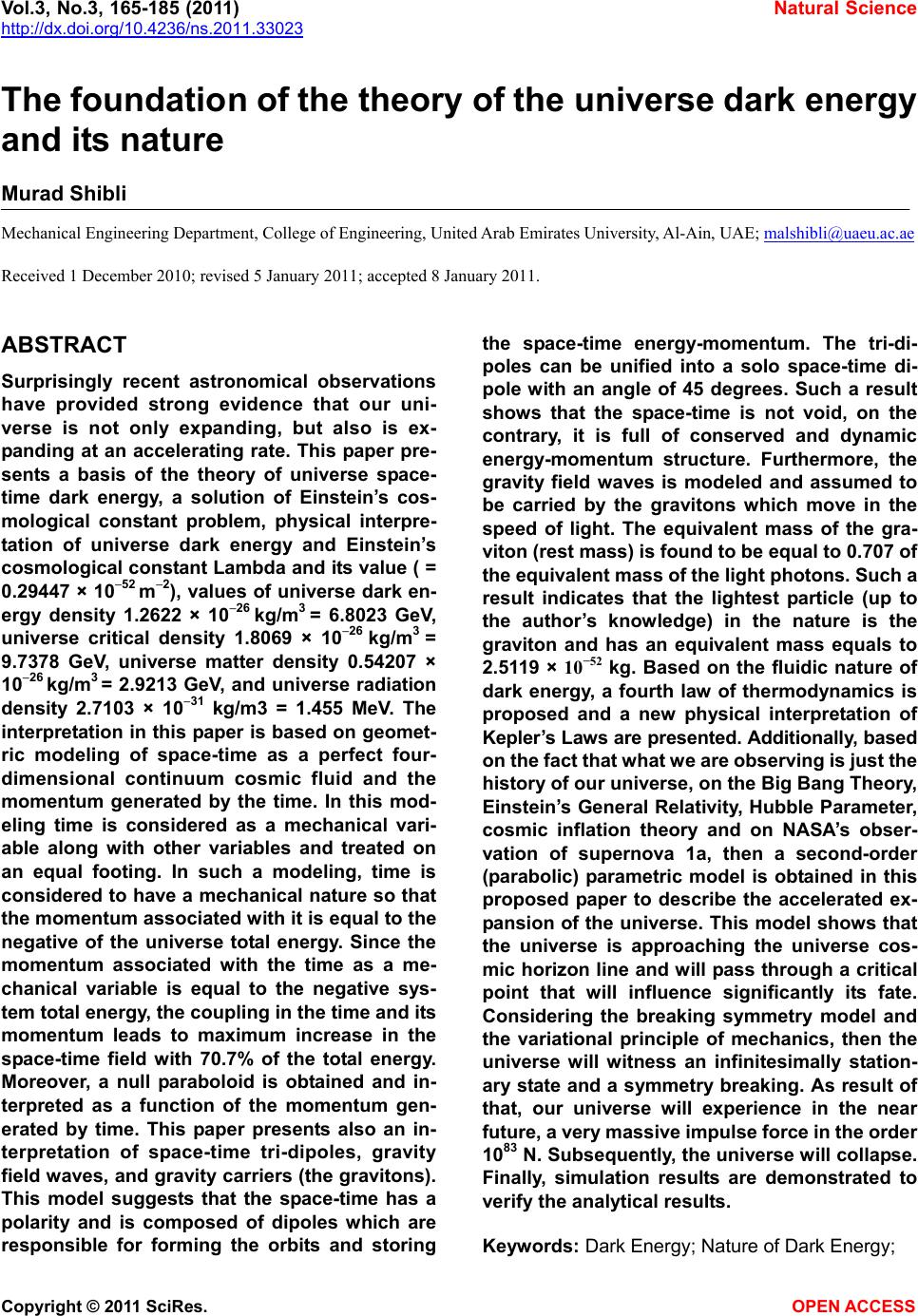 Vol.3, No.3, 165-185 (2011) Natural Science http://dx.doi.org/10.4236/ns.2011.33023 Copyright © 2011 SciRes. OPEN ACCESS The foundation of the theory of the universe dark energy and its nature Murad Shibli Mechanical Engineering Department, College of Engineering, United Arab Emirates University, Al-Ain, UAE; malshibli@uaeu.ac.ae Received 1 December 2010; revised 5 January 2011; accepted 8 January 2011. ABSTRACT Surprisingly recent astronomical observations have provided strong evidence that our uni- verse is not only expanding, but also is ex- panding at an accelerating rate. This paper pre- sents a basis of the theory of universe space- time dark energy, a solution of Einstein’s cos- mological constant problem, physical interpre- tation of universe dark energy and Einstein’s cosmological constant Lambda and its value ( = 0.29447 × 10−52 m−2), values of universe dark en- ergy density 1.2622 × 10−26 kg/m3 = 6.8023 GeV, universe critical density 1.8069 × 10−26 kg/m3 = 9.7378 GeV, universe matter density 0.54207 × 10−26 kg/m3 = 2.9213 GeV, and universe radiation density 2.7103 × 10−31 kg/m3 = 1.455 MeV. The interpretation in this paper is based on geomet- ric modeling of space-time as a perfect four- dimensional continuum cosmic fluid and the momentum generated by the time. In this mod- eling time is considered as a mechanical vari- able along with other variables and treated on an equal footing. In such a modeling, time is considered to have a mechanical nature so that the momentum associated with it is equal to the negative of the universe total energy. Since the momentum associated with the time as a me- chanical variable is equal to the negative sys- tem total energy, the coupling in the time and its momentum leads to maximum increase in the space-time field with 70.7% of the total energy. Moreover, a null paraboloid is obtained and in- terpreted as a function of the momentum gen- erated by time. This paper presents also an in- terpretation of space-time tri-dipoles, gravity field waves, and gravity carriers (the gravitons). This model suggests that the space-time has a polarity and is composed of dipoles which are responsible for forming the orbits and storing the space-time energy-momentum. The tri-di- poles can be unified into a solo space-time di- pole with an angle of 45 degrees. Such a result shows that the space-time is not void, on the contrary, it is full of conserved and dynamic energy-momentum structure. Furthermore, the gravity field waves is modeled and assumed to be carried by the gravitons which move in the speed of light. The equivalent mass of the gra- viton (rest mass) is found to be equal to 0.707 of the equivalent mass of the light photons. Such a result indicates that the lightest particle (up to the author’s knowledge) in the nature is the graviton and has an equivalent mass equals to 2.5119 × 10−52 kg. Based on the fluidic nature of dark energy, a fourth law of thermodynamics is proposed and a new physical interpretation of Kepler’s Laws are presented. Additionally, based on the fact that what we are observing is just the history of our universe, on the Big Bang Theory, Einstein’s General Relativity, Hubble Parameter, cosmic inflation theory and on NASA’s obser- vation of supernova 1a, then a second-order (parabolic) parametric model is obtained in this proposed paper to describe the accelerated ex- pansion of the universe. This model shows that the universe is approaching the universe cos- mic horizon line and will pass through a critical point that will influence significantly its fate. Considering the breaking symmetry model and the variational principle of mechanics, then the universe will witness an infinitesimally station- ary state and a symmetry breaking. As result of that, our universe will experience in the near future, a very massive impulse force in the order 1083 N. Subsequently, the universe will collapse. Finally, simulation results are demonstrated to verify the analytical results. Keywords: Dark Energy; Nature of Dark Energy; 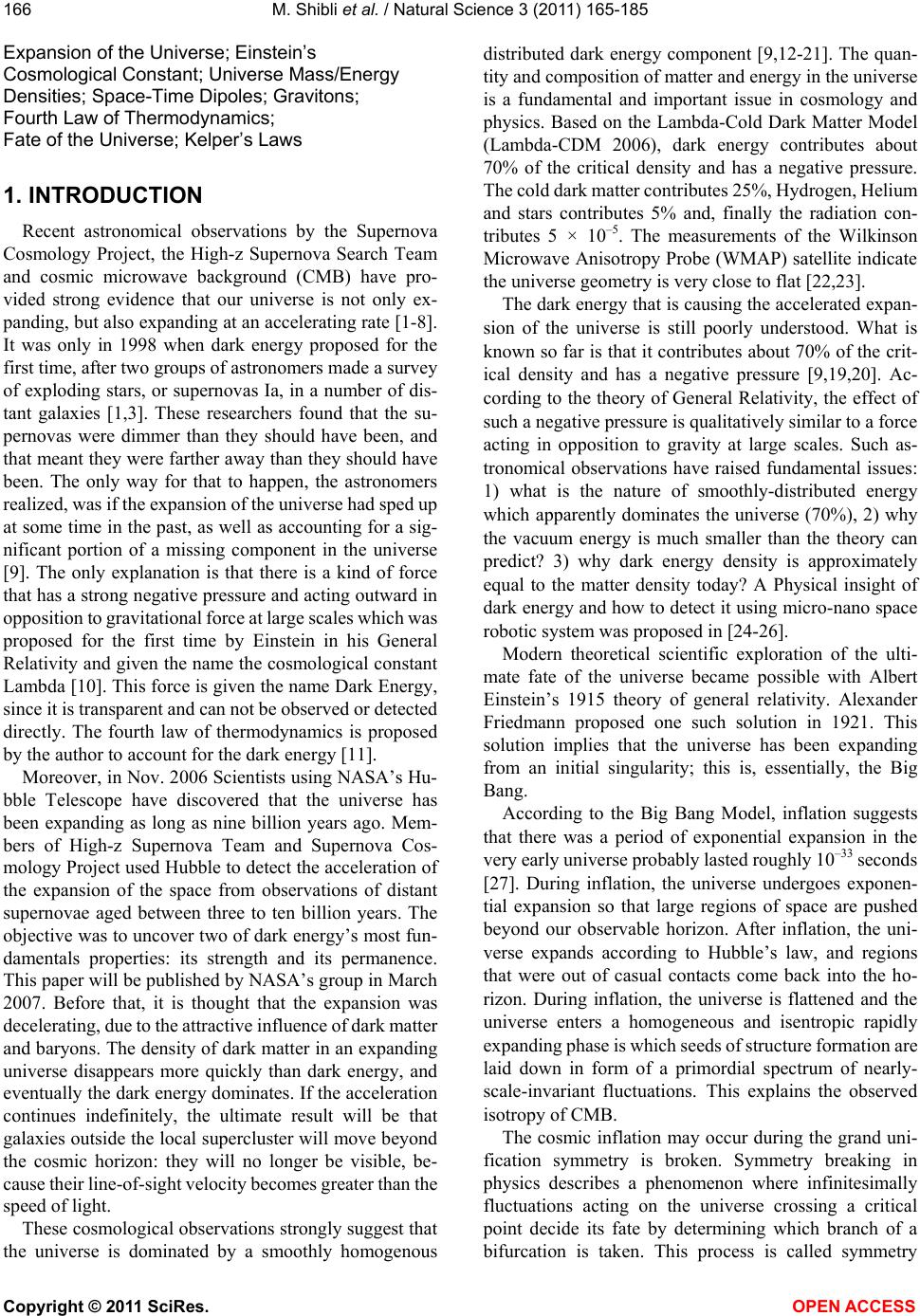 M. Shibli et al. / Natural Science 3 (2011) 165-185 Copyright © 2011 SciRes. OPEN ACCESS 166 Expansion of the Universe; Einstein’s Cosmological Constant; Universe Mass/Energy Densities; Space-Time Dipoles; Gravitons; Fourth Law of Thermodynamics; Fate of the Universe; Kelper’s Laws 1. INTRODUCTION Recent astronomical observations by the Supernova Cosmology Project, the High-z Supernova Search Team and cosmic microwave background (CMB) have pro- vided strong evidence that our universe is not only ex- panding, but also expanding at an accelerating rate [1-8]. It was only in 1998 when dark energy proposed for the first time, after two groups of astronomers made a survey of exploding stars, or supernovas Ia, in a number of dis- tant galaxies [1,3]. These researchers found that the su- pernovas were dimmer than they should have been, and that meant they were farther away than they should have been. The only way for that to happen, the astronomers realized, was if the expansion of the universe had sped up at some time in the past, as well as accounting for a sig- nificant portion of a missing component in the universe [9]. The only explanation is that there is a kind of force that has a strong negative pressure and acting outward in opposition to gravitational force at large scales which was proposed for the first time by Einstein in his General Relativity and given the name the cosmological constant Lambda [10]. This force is given the name Dark Energy, since it is transparent and can not be observed or detected directly. The fourth law of thermodynamics is proposed by the author to account for the dark energy [11]. Moreover, in Nov. 2006 Scientists using NASA’s Hu- bble Telescope have discovered that the universe has been expanding as long as nine billion years ago. Mem- bers of High-z Supernova Team and Supernova Cos- mology Project used Hubble to detect the acceleration of the expansion of the space from observations of distant supernovae aged between three to ten billion years. The objective was to uncover two of dark energy’s most fun- damentals properties: its strength and its permanence. This paper will be published by NASA’s group in March 2007. Before that, it is thought that the expansion was decelerating, due to the attractive influence of dark matter and baryons. The density of dark matter in an expanding universe disappears more quickly than dark energy, and eventually the dark energy dominates. If the acceleration continues indefinitely, the ultimate result will be that galaxies outside the local supercluster will move beyond the cosmic horizon: they will no longer be visible, be- cause their line-of-sight velocity becomes greater than the speed of light. These cosmological observations strongly suggest that the universe is dominated by a smoothly homogenous distributed dark energy component [9,12-21]. The quan- tity and composition of matter and energy in the universe is a fundamental and important issue in cosmology and physics. Based on the Lambda-Cold Dark Matter Model (Lambda-CDM 2006), dark energy contributes about 70% of the critical density and has a negative pressure. The cold dark matter contributes 25%, Hydrogen, Helium and stars contributes 5% and, finally the radiation con- tributes 5 × 10–5. The measurements of the Wilkinson Microwave Anisotropy Probe (WMAP) satellite indicate the universe geometry is very close to flat [22,23]. The dark energy that is causing the accelerated expan- sion of the universe is still poorly understood. What is known so far is that it contributes about 70% of the crit- ical density and has a negative pressure [9,19,20]. Ac- cording to the theory of General Relativity, the effect of such a negative pressure is qualitatively similar to a force acting in opposition to gravity at large scales. Such as- tronomical observations have raised fundamental issues: 1) what is the nature of smoothly-distributed energy which apparently dominates the universe (70%), 2) why the vacuum energy is much smaller than the theory can predict? 3) why dark energy density is approximately equal to the matter density today? A Physical insight of dark energy and how to detect it using micro-nano space robotic system was proposed in [24-26]. Modern theoretical scientific exploration of the ulti- mate fate of the universe became possible with Albert Einstein’s 1915 theory of general relativity. Alexander Friedmann proposed one such solution in 1921. This solution implies that the universe has been expanding from an initial singularity; this is, essentially, the Big Bang. According to the Big Bang Model, inflation suggests that there was a period of exponential expansion in the very early universe probably lasted roughly 10–33 seconds [27]. During inflation, the universe undergoes exponen- tial expansion so that large regions of space are pushed beyond our observable horizon. After inflation, the uni- verse expands according to Hubble’s law, and regions that were out of casual contacts come back into the ho- rizon. During inflation, the universe is flattened and the universe enters a homogeneous and isentropic rapidly expanding phase is which seeds of structure formation are laid down in form of a primordial spectrum of nearly- scale-invariant fluctuations. This explains the observed isotropy of CMB. The cosmic inflation may occur during the grand uni- fication symmetry is broken. Symmetry breaking in physics describes a phenomenon where infinitesimally fluctuations acting on the universe crossing a critical point decide its fate by determining which branch of a bifurcation is taken. This process is called symmetry 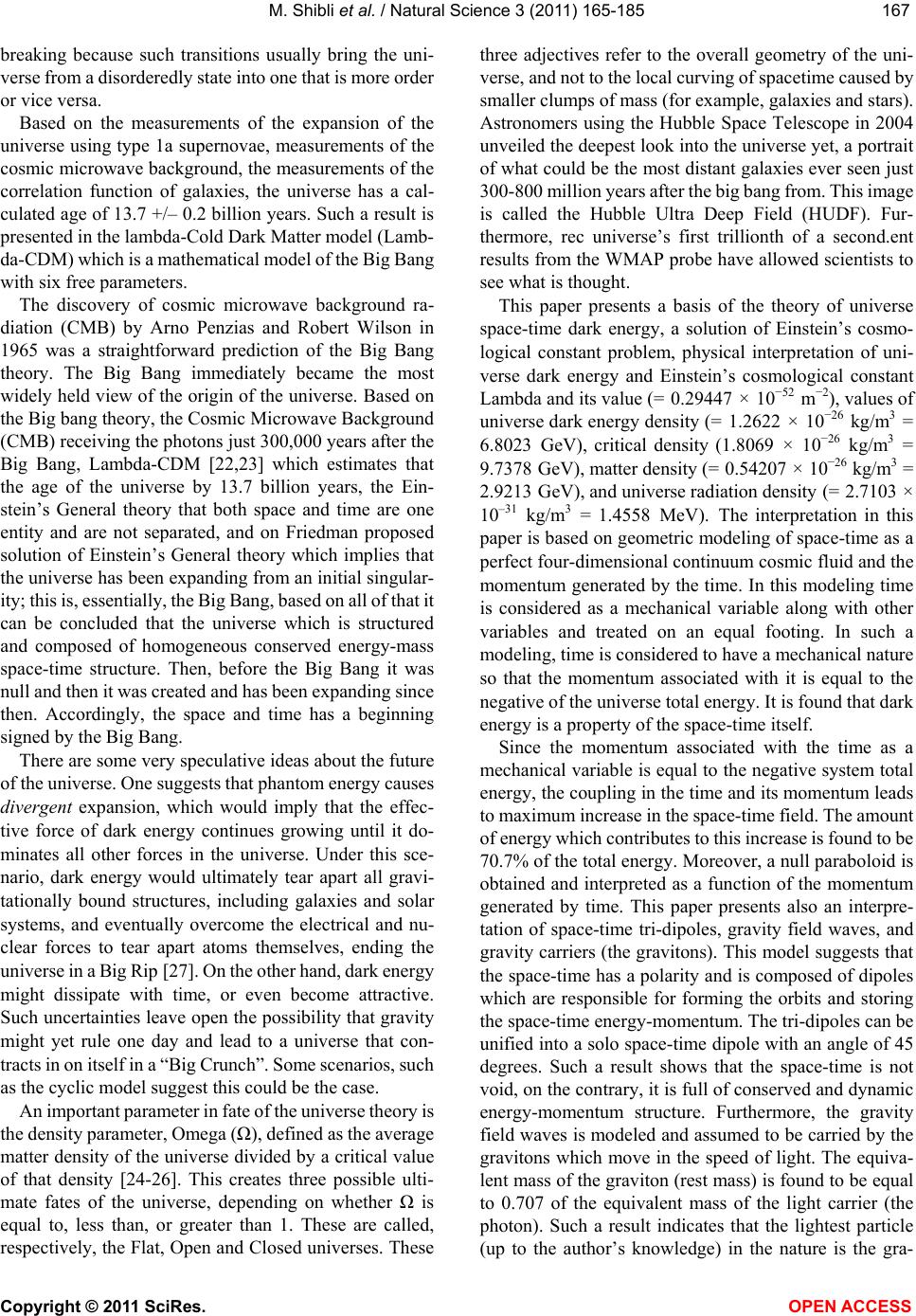 M. Shibli et al. / Natural Science 3 (2011) 165-185 Copyright © 2011 SciRes. OPEN ACCESS 167167 breaking because such transitions usually bring the uni- verse from a disorderedly state into one that is more order or vice versa. Based on the measurements of the expansion of the universe using type 1a supernovae, measurements of the cosmic microwave background, the measurements of the correlation function of galaxies, the universe has a cal- culated age of 13.7 +/– 0.2 billion years. Such a result is presented in the lambda-Cold Dark Matter model (Lamb- da-CDM) which is a mathematical model of the Big Bang with six free parameters. The discovery of cosmic microwave background ra- diation (CMB) by Arno Penzias and Robert Wilson in 1965 was a straightforward prediction of the Big Bang theory. The Big Bang immediately became the most widely held view of the origin of the universe. Based on the Big bang theory, the Cosmic Microwave Background (CMB) receiving the photons just 300,000 years after the Big Bang, Lambda-CDM [22,23] which estimates that the age of the universe by 13.7 billion years, the Ein- stein’s General theory that both space and time are one entity and are not separated, and on Friedman proposed solution of Einstein’s General theory which implies that the universe has been expanding from an initial singular- ity; this is, essentially, the Big Bang, based on all of that it can be concluded that the universe which is structured and composed of homogeneous conserved energy-mass space-time structure. Then, before the Big Bang it was null and then it was created and has been expanding since then. Accordingly, the space and time has a beginning signed by the Big Bang. There are some very speculative ideas about the future of the universe. One suggests that phantom energy causes divergent expansion, which would imply that the effec- tive force of dark energy continues growing until it do- minates all other forces in the universe. Under this sce- nario, dark energy would ultimately tear apart all gravi- tationally bound structures, including galaxies and solar systems, and eventually overcome the electrical and nu- clear forces to tear apart atoms themselves, ending the universe in a Big Rip [27]. On the other hand, dark energy might dissipate with time, or even become attractive. Such uncertainties leave open the possibility that gravity might yet rule one day and lead to a universe that con- tracts in on itself in a “Big Crunch”. Some scenarios, such as the cyclic model suggest this could be the case. An important parameter in fate of the universe theory is the density parameter, Omega (Ω), defined as the average matter density of the universe divided by a critical value of that density [24-26]. This creates three possible ulti- mate fates of the universe, depending on whether Ω is equal to, less than, or greater than 1. These are called, respectively, the Flat, Open and Closed universes. These three adjectives refer to the overall geometry of the uni- verse, and not to the local curving of spacetime caused by smaller clumps of mass (for example, galaxies and stars). Astronomers using the Hubble Space Telescope in 2004 unveiled the deepest look into the universe yet, a portrait of what could be the most distant galaxies ever seen just 300-800 million years after the big bang from. This image is called the Hubble Ultra Deep Field (HUDF). Fur- thermore, rec universe’s first trillionth of a second.ent results from the WMAP probe have allowed scientists to see what is thought. This paper presents a basis of the theory of universe space-time dark energy, a solution of Einstein’s cosmo- logical constant problem, physical interpretation of uni- verse dark energy and Einstein’s cosmological constant Lambda and its value (= 0.29447 × 10−52 m−2), values of universe dark energy density (= 1.2622 × 10−26 kg/m3 = 6.8023 GeV), critical density (1.8069 × 10−26 kg/m3 = 9.7378 GeV), matter density (= 0.54207 × 10−26 kg/m3 = 2.9213 GeV), and universe radiation density (= 2.7103 × 10–31 kg/m3 = 1.4558 MeV). The interpretation in this paper is based on geometric modeling of space-time as a perfect four-dimensional continuum cosmic fluid and the momentum generated by the time. In this modeling time is considered as a mechanical variable along with other variables and treated on an equal footing. In such a modeling, time is considered to have a mechanical nature so that the momentum associated with it is equal to the negative of the universe total energy. It is found that dark energy is a property of the space-time itself. Since the momentum associated with the time as a mechanical variable is equal to the negative system total energy, the coupling in the time and its momentum leads to maximum increase in the space-time field. The amount of energy which contributes to this increase is found to be 70.7% of the total energy. Moreover, a null paraboloid is obtained and interpreted as a function of the momentum generated by time. This paper presents also an interpre- tation of space-time tri-dipoles, gravity field waves, and gravity carriers (the gravitons). This model suggests that the space-time has a polarity and is composed of dipoles which are responsible for forming the orbits and storing the space-time energy-momentum. The tri-dipoles can be unified into a solo space-time dipole with an angle of 45 degrees. Such a result shows that the space-time is not void, on the contrary, it is full of conserved and dynamic energy-momentum structure. Furthermore, the gravity field waves is modeled and assumed to be carried by the gravitons which move in the speed of light. The equiva- lent mass of the graviton (rest mass) is found to be equal to 0.707 of the equivalent mass of the light carrier (the photon). Such a result indicates that the lightest particle (up to the author’s knowledge) in the nature is the gra- 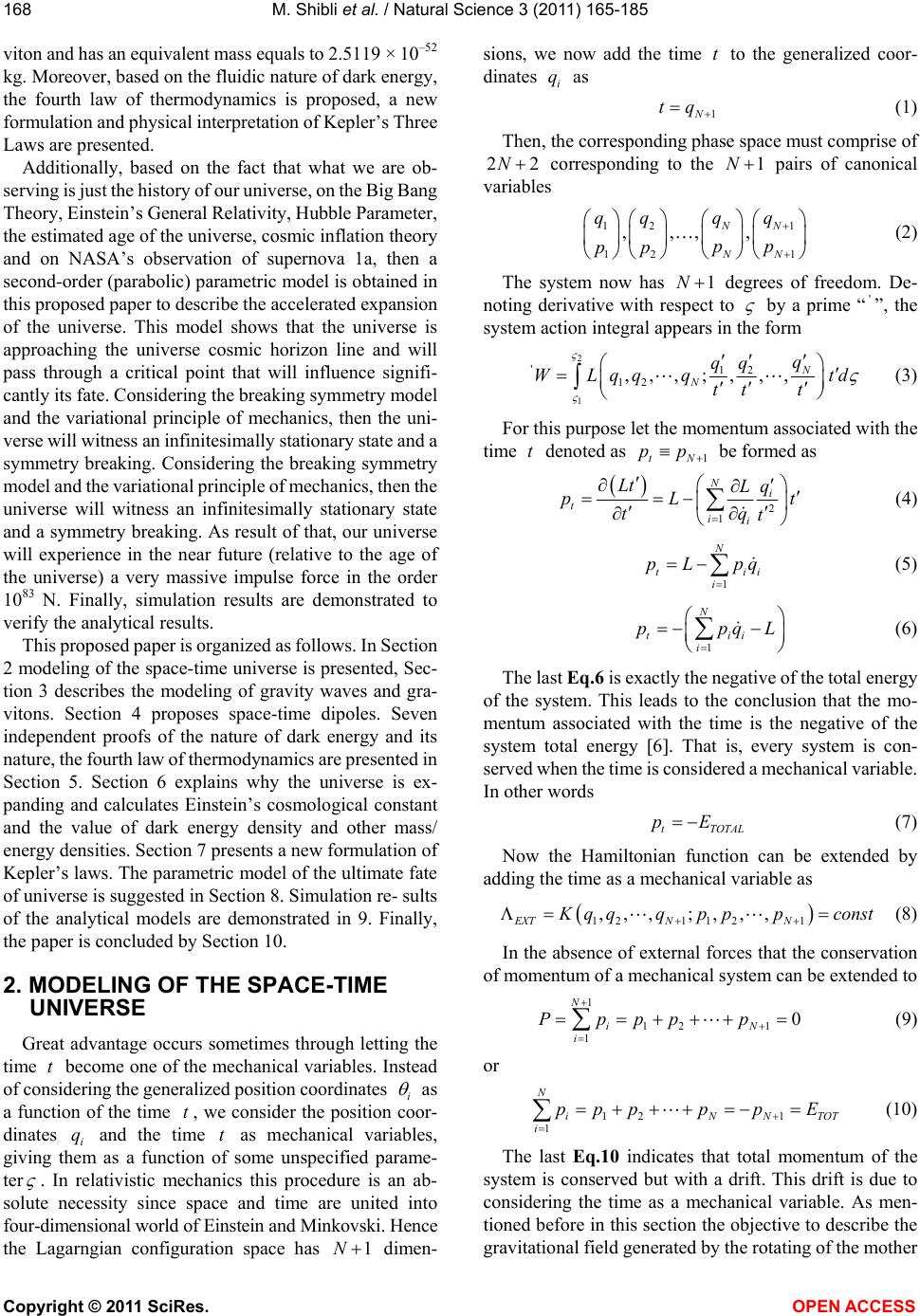 M. Shibli et al. / Natural Science 3 (2011) 165-185 Copyright © 2011 SciRes. OPEN ACCESS 168 viton and has an equivalent mass equals to 2.5119 × 10–52 kg. Moreover, based on the fluidic nature of dark energy, the fourth law of thermodynamics is proposed, a new formulation and physical interpretation of Kepler’s Three Laws are presented. Additionally, based on the fact that what we are ob- serving is just the history of our universe, on the Big Bang Theory, Einstein’s General Relativity, Hubble Parameter, the estimated age of the universe, cosmic inflation theory and on NASA’s observation of supernova 1a, then a second-order (parabolic) parametric model is obtained in this proposed paper to describe the accelerated expansion of the universe. This model shows that the universe is approaching the universe cosmic horizon line and will pass through a critical point that will influence signifi- cantly its fate. Considering the breaking symmetry model and the variational principle of mechanics, then the uni- verse will witness an infinitesimally stationary state and a symmetry breaking. Considering the breaking symmetry model and the variational principle of mechanics, then the universe will witness an infinitesimally stationary state and a symmetry breaking. As result of that, our universe will experience in the near future (relative to the age of the universe) a very massive impulse force in the order 1083 N. Finally, simulation results are demonstrated to verify the analytical results. This proposed paper is organized as follows. In Section 2 modeling of the space-time universe is presented, Sec- tion 3 describes the modeling of gravity waves and gra- vitons. Section 4 proposes space-time dipoles. Seven independent proofs of the nature of dark energy and its nature, the fourth law of thermodynamics are presented in Section 5. Section 6 explains why the universe is ex- panding and calculates Einstein’s cosmological constant and the value of dark energy density and other mass/ energy densities. Section 7 presents a new formulation of Kepler’s laws. The parametric model of the ultimate fate of universe is suggested in Section 8. Simulation re- sults of the analytical models are demonstrated in 9. Finally, the paper is concluded by Section 10. 2. MODELING OF THE SPACE-TIME UNIVERSE Great advantage occurs sometimes through letting the time t become one of the mechanical variables. Instead of considering the generalized position coordinates i as a function of the time t, we consider the position coor- dinates i q and the time t as mechanical variables, giving them as a function of some unspecified parame- ter . In relativistic mechanics this procedure is an ab- solute necessity since space and time are united into four-dimensional world of Einstein and Minkovski. Hence the Lagarngian configuration space has 1N dimen- sions, we now add the time t to the generalized coor- dinates i q as 1N tq (1) Then, the corresponding phase space must comprise of 22N corresponding to the 1N pairs of canonical variables 112 1 12 ,,, , NN NN qq qq pp pp (2) The system now has 1N degrees of freedom. De- noting derivative with respect to by a prime “'”, the system action integral appears in the form 2 1 '12 12 ,,,; ,,, N N q qq WLqq qtd tt t (3) For this purpose let the momentum associated with the time t denoted as 1tN pp be formed as 2 1 N i t ii Lt q L pL t tq t (4) 1 N tii i pL pq (5) 1 N tii i ppqL (6) The last Eq.6 is exactly the negative of the total energy of the system. This leads to the conclusion that the mo- mentum associated with the time is the negative of the system total energy [6]. That is, every system is con- served when the time is considered a mechanical variable. In other words tTOTAL pE (7) Now the Hamiltonian function can be extended by adding the time as a mechanical variable as 1211 21 ,,,;,,, EXTN N qqqp ppconst (8) In the absence of external forces that the conservation of momentum of a mechanical system can be extended to 1 12 1 1 0 N iN i Pppp p (9) or 12 1 1 N iNNTOT i ppppp E (10) The last Eq.10 indicates that total momentum of the system is conserved but with a drift. This drift is due to considering the time as a mechanical variable. As men- tioned before in this section the objective to describe the gravitational field generated by the rotating of the mother 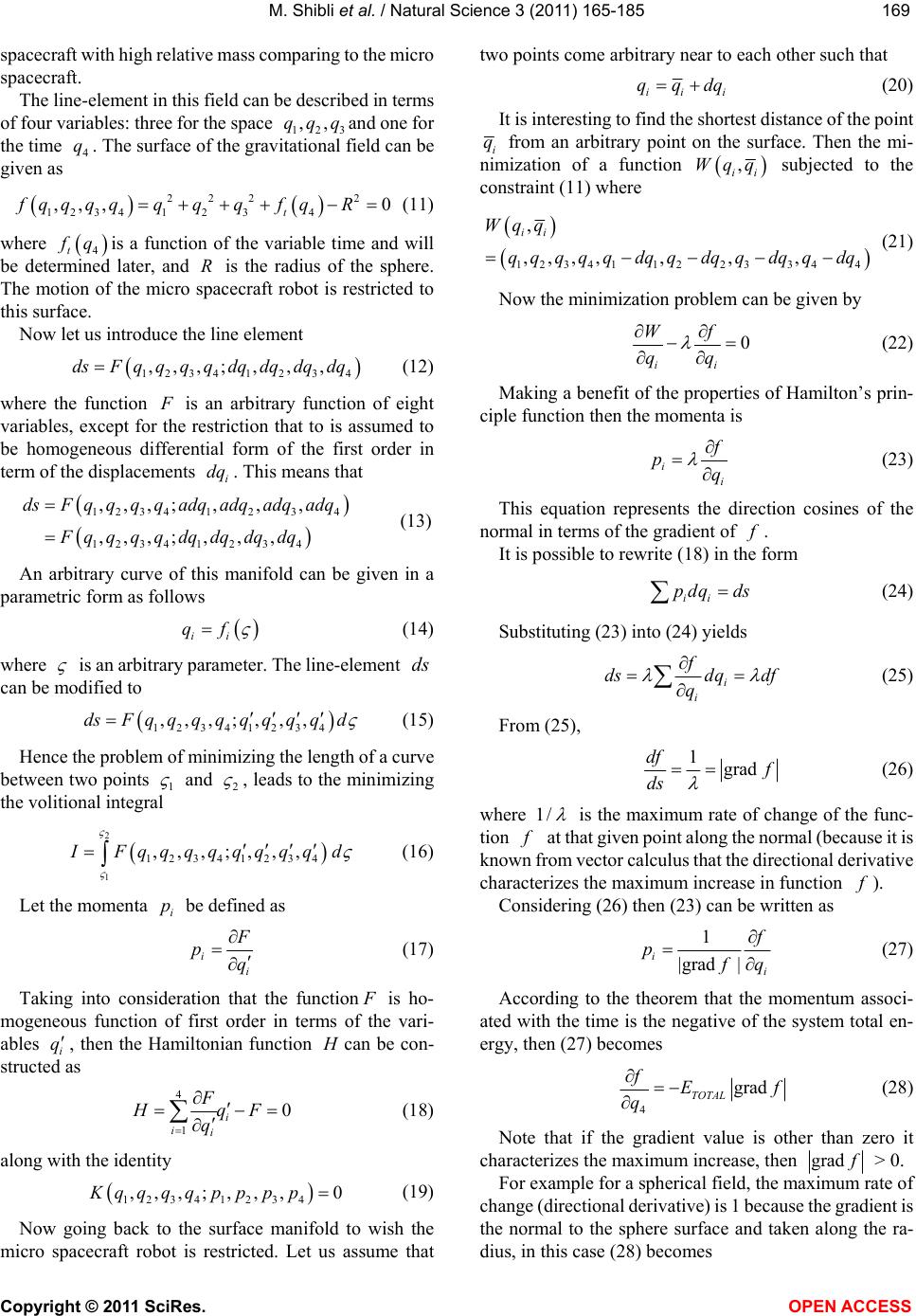 M. Shibli et al. / Natural Science 3 (2011) 165-185 Copyright © 2011 SciRes. OPEN ACCESS 169169 spacecraft with high relative mass comparing to the micro spacecraft. The line-element in this field can be described in terms of four variables: three for the space 123 ,,qqqand one for the time 4 q. The surface of the gravitational field can be given as 222 2 12341 2 34 ,,, 0 t fqqqqqqqf qR (11) where 4t qis a function of the variable time and will be determined later, and R is the radius of the sphere. The motion of the micro spacecraft robot is restricted to this surface. Now let us introduce the line element 12341234 ,,,; ,,,ds Fqqqqdqdqdqdq (12) where the function is an arbitrary function of eight variables, except for the restriction that to is assumed to be homogeneous differential form of the first order in term of the displacements i dq . This means that 12341234 12341234 ,,,; ,,, ,,,; ,,, dsFqq qq adqadq adqadq Fqqqqdqdqdqdq (13) An arbitrary curve of this manifold can be given in a parametric form as follows ii qf (14) where is an arbitrary parameter. The line-element ds can be modified to 12341234 ,,,;,,,dsFqqqqqqqq d (15) Hence the problem of minimizing the length of a curve between two points 1 and 2 , leads to the minimizing the volitional integral 2 1 12341234 ,,,;,,, Fqqqqqqqq d (16) Let the momenta i p be defined as i i pq (17) Taking into consideration that the function is ho- mogeneous function of first order in terms of the vari- ables i q, then the Hamiltonian function can be con- structed as 4 1 0 i ii F HqF q (18) along with the identity 12341 2 34 ,,,;, ,,0Kqqqqpppp (19) Now going back to the surface manifold to wish the micro spacecraft robot is restricted. Let us assume that two points come arbitrary near to each other such that iii qqdq (20) It is interesting to find the shortest distance of the point i q from an arbitrary point on the surface. Then the mi- nimization of a function , ii Wqq subjected to the constraint (11) where 123411223344 , ,,,, ,,, ii Wqq qq qq qdqqdq qdqqdq (21) Now the minimization problem can be given by 0 ii Wf qq (22) Making a benefit of the properties of Hamilton’s prin- ciple function then the momenta is i i pq (23) This equation represents the direction cosines of the normal in terms of the gradient of . It is possible to rewrite (18) in the form ii pdq ds (24) Substituting (23) into (24) yields i i f dsdq df q (25) From (25), 1grad df ds (26) where 1/ is the maximum rate of change of the func- tion at that given point along the normal (because it is known from vector calculus that the directional derivative characterizes the maximum increase in function ). Considering (26) then (23) can be written as 1 |grad | i i p q (27) According to the theorem that the momentum associ- ated with the time is the negative of the system total en- ergy, then (27) becomes 4 grad TOTAL fEf q (28) Note that if the gradient value is other than zero it characterizes the maximum increase, then grad > 0. For example for a spherical field, the maximum rate of change (directional derivative) is 1 because the gradient is the normal to the sphere surface and taken along the ra- dius, in this case (28) becomes 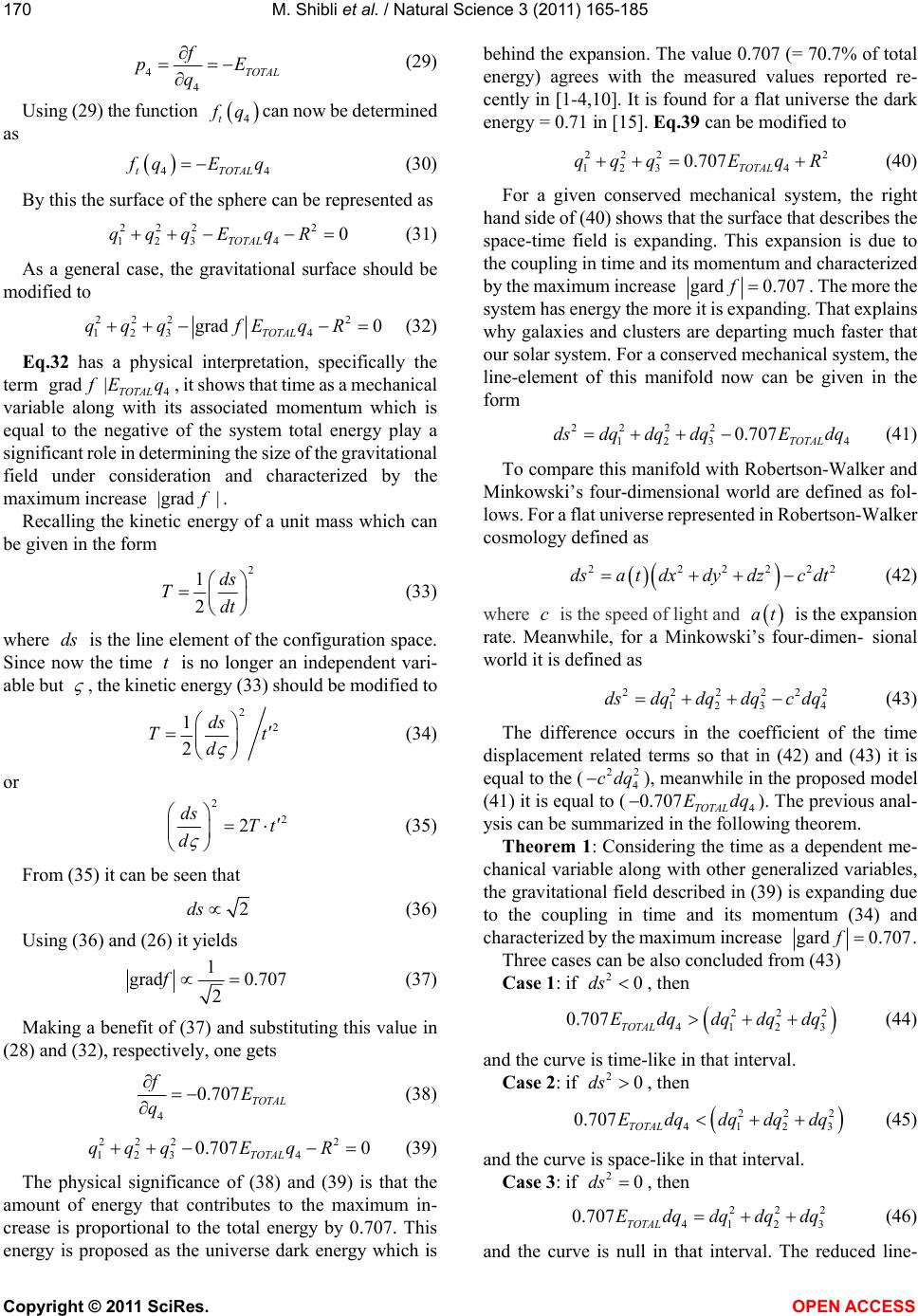 M. Shibli et al. / Natural Science 3 (2011) 165-185 Copyright © 2011 SciRes. OPEN ACCESS 170 4 4 TOTAL pE q (29) Using (29) the function 4t qcan now be determined as 44tTOTAL qEq (30) By this the surface of the sphere can be represented as 222 2 1234 0 TOTAL qqqE qR (31) As a general case, the gravitational surface should be modified to 222 2 123 4 grad 0 TOTAL qqqfEqR (32) Eq.32 has a physical interpretation, specifically the term 4 grad |TOTAL Eq, it shows that time as a mechanical variable along with its associated momentum which is equal to the negative of the system total energy play a significant role in determining the size of the gravitational field under consideration and characterized by the maximum increase |grad | . Recalling the kinetic energy of a unit mass which can be given in the form 2 1 2 ds Tdt (33) where ds is the line element of the configuration space. Since now the time t is no longer an independent vari- able but , the kinetic energy (33) should be modified to 2 2 1 2 ds Tt d (34) or 2 2 2 ds Tt d (35) From (35) it can be seen that 2ds (36) Using (36) and (26) it yields 1 grad 0.707 2 f (37) Making a benefit of (37) and substituting this value in (28) and (32), respectively, one gets 4 0.707 TOTAL fE q (38) 222 2 123 4 0.707 0 TOTAL qqqEqR (39) The physical significance of (38) and (39) is that the amount of energy that contributes to the maximum in- crease is proportional to the total energy by 0.707. This energy is proposed as the universe dark energy which is behind the expansion. The value 0.707 (= 70.7% of total energy) agrees with the measured values reported re- cently in [1-4,10]. It is found for a flat universe the dark energy = 0.71 in [15]. Eq.39 can be modified to 222 2 123 4 0.707 TOTAL qqqE qR (40) For a given conserved mechanical system, the right hand side of (40) shows that the surface that describes the space-time field is expanding. This expansion is due to the coupling in time and its momentum and characterized by the maximum increase gard 0.707f. The more the system has energy the more it is expanding. That explains why galaxies and clusters are departing much faster that our solar system. For a conserved mechanical system, the line-element of this manifold now can be given in the form 2 222 123 4 0.707 TOTAL dsdqdq dqEdq (41) To compare this manifold with Robertson-Walker and Minkowski’s four-dimensional world are defined as fol- lows. For a flat universe represented in Robertson-Walker cosmology defined as 222222 dsatdxdydzcdt (42) where c is the speed of light and at is the expansion rate. Meanwhile, for a Minkowski’s four-dimen- sional world it is defined as 222222 123 4 dsdqdqdqc dq (43) The difference occurs in the coefficient of the time displacement related terms so that in (42) and (43) it is equal to the (22 4 cdq), meanwhile in the proposed model (41) it is equal to (4 0.707 TOTAL Edq ). The previous anal- ysis can be summarized in the following theorem. Theorem 1: Considering the time as a dependent me- chanical variable along with other generalized variables, the gravitational field described in (39) is expanding due to the coupling in time and its momentum (34) and characterized by the maximum increase gard 0.707f. Three cases can be also concluded from (43) Case 1: if 20ds , then 222 4123 0.707 TOTAL E dqdqdqdq (44) and the curve is time-like in that interval. Case 2: if 20ds, then 222 4123 0.707 TOTAL Edqdqdqdq (45) and the curve is space-like in that interval. Case 3: if 20ds , then 222 4123 0.707 TOTAL E dqdqdqdq (46) and the curve is null in that interval. The reduced line- 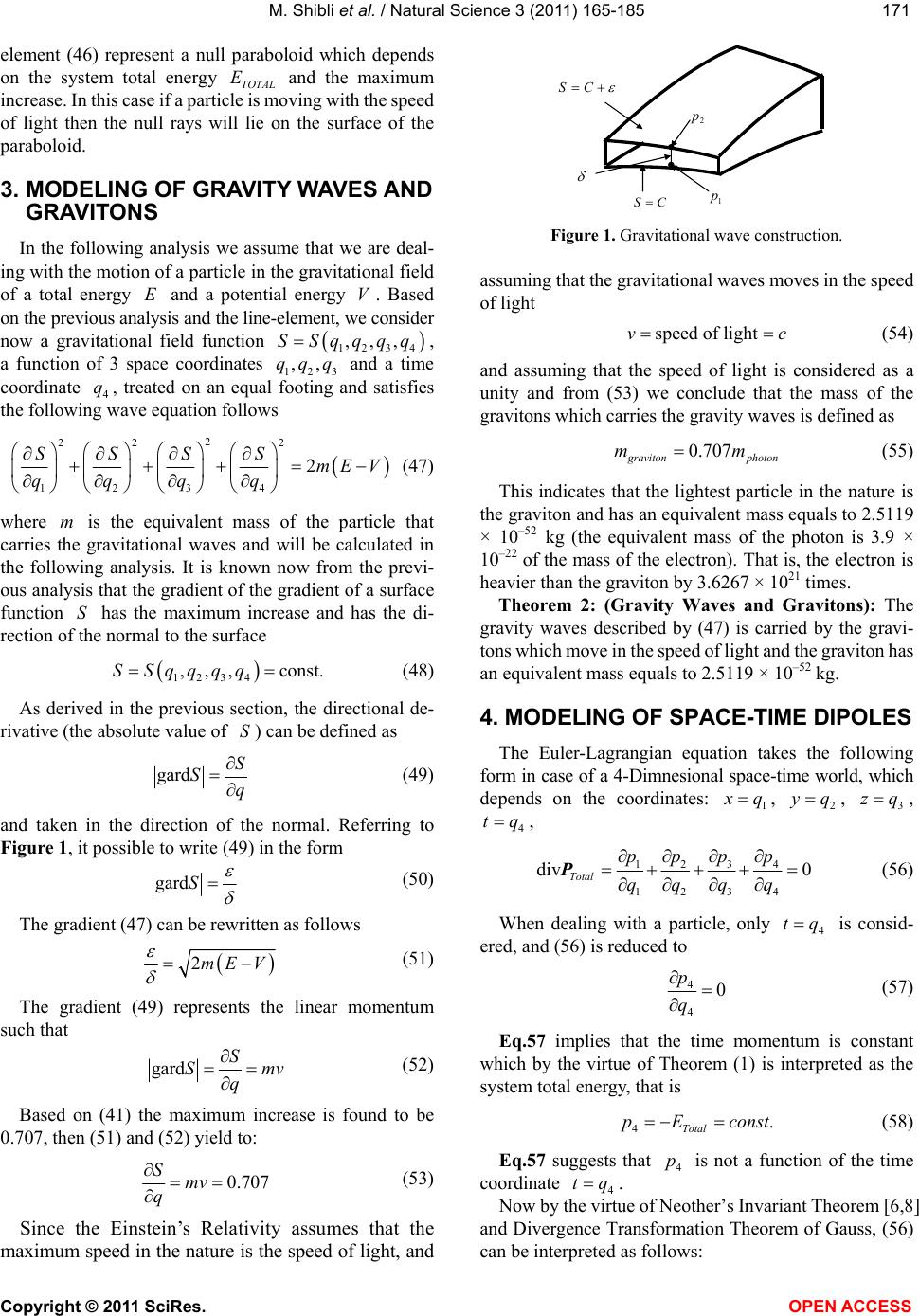 M. Shibli et al. / Natural Science 3 (2011) 165-185 Copyright © 2011 SciRes. OPEN ACCESS 171171 element (46) represent a null paraboloid which depends on the system total energy TOTAL E and the maximum increase. In this case if a particle is moving with the speed of light then the null rays will lie on the surface of the paraboloid. 3. MODELING OF GRAVITY WAVES AND GRAVITONS In the following analysis we assume that we are deal- ing with the motion of a particle in the gravitational field of a total energy E and a potential energy V. Based on the previous analysis and the line-element, we consider now a gravitational field function 1234 ,,,SSqqqq, a function of 3 space coordinates 123 ,,qqq and a time coordinate 4 q, treated on an equal footing and satisfies the following wave equation follows 2 22 2 1234 2 SSSS mE V qq qq (47) where m is the equivalent mass of the particle that carries the gravitational waves and will be calculated in the following analysis. It is known now from the previ- ous analysis that the gradient of the gradient of a surface function S has the maximum increase and has the di- rection of the normal to the surface 1234 ,, ,const.SSqqqq (48) As derived in the previous section, the directional de- rivative (the absolute value of S) can be defined as gard S Sq (49) and taken in the direction of the normal. Referring to Figure 1, it possible to write (49) in the form gardS (50) The gradient (47) can be rewritten as follows 2mE V (51) The gradient (49) represents the linear momentum such that gard S Smv q (52) Based on (41) the maximum increase is found to be 0.707, then (51) and (52) yield to: 0.707 Smv q (53) Since the Einstein’s Relativity assumes that the maximum speed in the nature is the speed of light, and CS CS 1 p 2 p Figure 1. Gravitational wave construction. assuming that the gravitational waves moves in the speed of light speed of lightvc (54) and assuming that the speed of light is considered as a unity and from (53) we conclude that the mass of the gravitons which carries the gravity waves is defined as 0.707 raviton photon mm (55) This indicates that the lightest particle in the nature is the graviton and has an equivalent mass equals to 2.5119 × 10–52 kg (the equivalent mass of the photon is 3.9 × 10–22 of the mass of the electron). That is, the electron is heavier than the graviton by 3.6267 × 1021 times. Theorem 2: (Gravity Waves and Gravitons): The gravity waves described by (47) is carried by the gravi- tons which move in the speed of light and the graviton has an equivalent mass equals to 2.5119 × 10–52 kg. 4. MODELING OF SPACE-TIME DIPOLES The Euler-Lagrangian equation takes the following form in case of a 4-Dimnesional space-time world, which depends on the coordinates: 1 q, 2 yq, 3 zq , 4 tq , 3 12 4 1234 div 0 Total p pp p qqqq P (56) When dealing with a particle, only 4 tq is consid- ered, and (56) is reduced to 4 4 0 p q (57) Eq.57 implies that the time momentum is constant which by the virtue of Theorem (1) is interpreted as the system total energy, that is 4. Total pE const (58) Eq.57 suggests that 4 p is not a function of the time coordinate 4 tq . Now by the virtue of Neother’s Invariant Theorem [6,8] and Divergence Transformation Theorem of Gauss, (56) can be interpreted as follows: 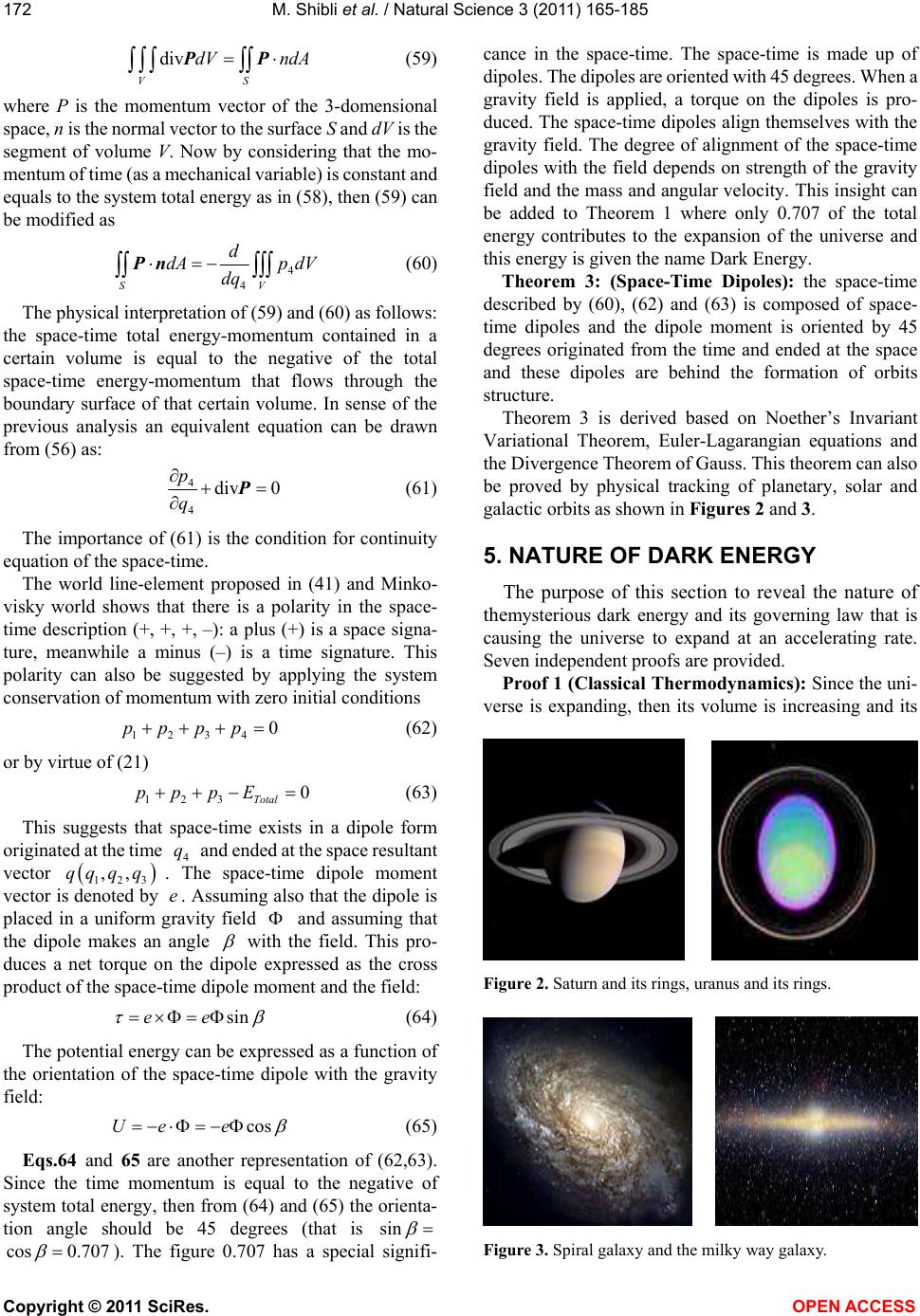 M. Shibli et al. / Natural Science 3 (2011) 165-185 Copyright © 2011 SciRes. OPEN ACCESS 172 div VS dV ndA PP (59) where P is the momentum vector of the 3-domensional space, n is the normal vector to the surface S and dV is the segment of volume V. Now by considering that the mo- mentum of time (as a mechanical variable) is constant and equals to the system total energy as in (58), then (59) can be modified as 4 4 SV d dAp dV dq Pn (60) The physical interpretation of (59) and (60) as follows: the space-time total energy-momentum contained in a certain volume is equal to the negative of the total space-time energy-momentum that flows through the boundary surface of that certain volume. In sense of the previous analysis an equivalent equation can be drawn from (56) as: 4 4 div 0 p q P (61) The importance of (61) is the condition for continuity equation of the space-time. The world line-element proposed in (41) and Minko- visky world shows that there is a polarity in the space- time description (+, +, +, –): a plus (+) is a space signa- ture, meanwhile a minus (–) is a time signature. This polarity can also be suggested by applying the system conservation of momentum with zero initial conditions 1234 0pp pp (62) or by virtue of (21) 123 0 Total pp pE (63) This suggests that space-time exists in a dipole form originated at the time 4 q and ended at the space resultant vector 123 ,,qq qq. The space-time dipole moment vector is denoted by e. Assuming also that the dipole is placed in a uniform gravity field and assuming that the dipole makes an angle with the field. This pro- duces a net torque on the dipole expressed as the cross product of the space-time dipole moment and the field: sinee (64) The potential energy can be expressed as a function of the orientation of the space-time dipole with the gravity field: cosUe e (65) Eqs.64 and 65 are another representation of (62,63). Since the time momentum is equal to the negative of system total energy, then from (64) and (65) the orienta- tion angle should be 45 degrees (that is sin cos 0.707 ). The figure 0.707 has a special signifi- cance in the space-time. The space-time is made up of dipoles. The dipoles are oriented with 45 degrees. When a gravity field is applied, a torque on the dipoles is pro- duced. The space-time dipoles align themselves with the gravity field. The degree of alignment of the space-time dipoles with the field depends on strength of the gravity field and the mass and angular velocity. This insight can be added to Theorem 1 where only 0.707 of the total energy contributes to the expansion of the universe and this energy is given the name Dark Energy. Theorem 3: (Space-Time Dipoles): the space-time described by (60), (62) and (63) is composed of space- time dipoles and the dipole moment is oriented by 45 degrees originated from the time and ended at the space and these dipoles are behind the formation of orbits structure. Theorem 3 is derived based on Noether’s Invariant Variational Theorem, Euler-Lagarangian equations and the Divergence Theorem of Gauss. This theorem can also be proved by physical tracking of planetary, solar and galactic orbits as shown in Figures 2 and 3. 5. NATURE OF DARK ENERGY The purpose of this section to reveal the nature of themysterious dark energy and its governing law that is causing the universe to expand at an accelerating rate. Seven independent proofs are provided. Proof 1 (Classical Thermodynamics): Since the uni- verse is expanding, then its volume is increasing and its Figure 2. Saturn and its rings, uranus and its rings. Figure 3. Spiral galaxy and the milky way galaxy. 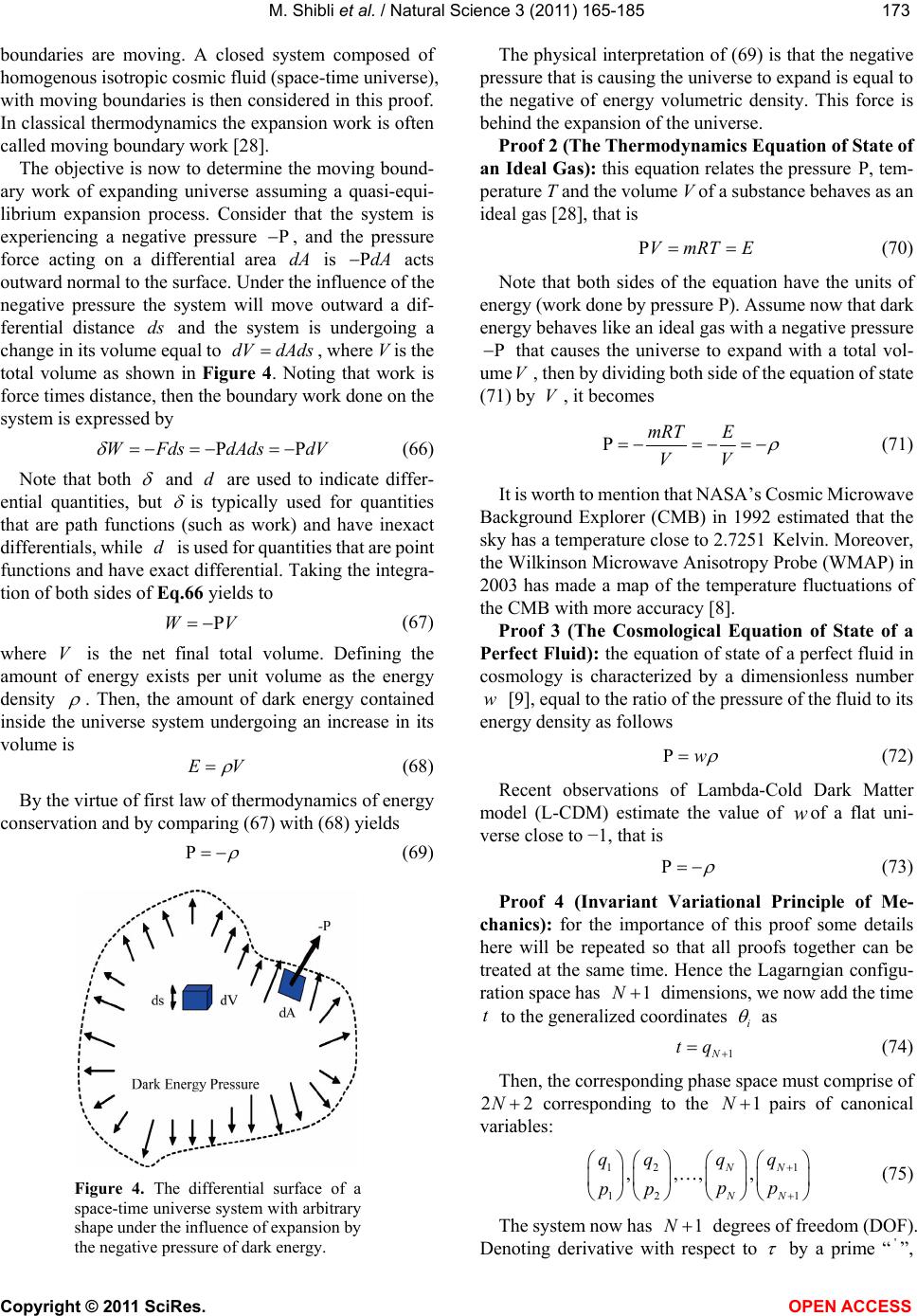 M. Shibli et al. / Natural Science 3 (2011) 165-185 Copyright © 2011 SciRes. OPEN ACCESS 173173 boundaries are moving. A closed system composed of homogenous isotropic cosmic fluid (space-time universe), with moving boundaries is then considered in this proof. In classical thermodynamics the expansion work is often called moving boundary work [28]. The objective is now to determine the moving bound- ary work of expanding universe assuming a quasi-equi- librium expansion process. Consider that the system is experiencing a negative pressure , and the pressure force acting on a differential area dA is dA acts outward normal to the surface. Under the influence of the negative pressure the system will move outward a dif- ferential distance ds and the system is undergoing a change in its volume equal to dV dAds, where V is the total volume as shown in Figure 4. Noting that work is force times distance, then the boundary work done on the system is expressed by WFds dAds dV (66) Note that both and d are used to indicate differ- ential quantities, but is typically used for quantities that are path functions (such as work) and have inexact differentials, while d is used for quantities that are point functions and have exact differential. Taking the integra- tion of both sides of Eq.66 yields to VW (67) where V is the net final total volume. Defining the amount of energy exists per unit volume as the energy density . Then, the amount of dark energy contained inside the universe system undergoing an increase in its volume is EV (68) By the virtue of first law of thermodynamics of energy conservation and by comparing (67) with (68) yields (69) Figure 4. The differential surface of a space-time universe system with arbitrary shape under the influence of expansion by the negative pressure of dark energy. The physical interpretation of (69) is that the negative pressure that is causing the universe to expand is equal to the negative of energy volumetric density. This force is behind the expansion of the universe. Proof 2 (The Thermodynamics Equation of State of an Ideal Gas): this equation relates the pressure P, tem- perature T and the volume V of a substance behaves as an ideal gas [28], that is VmRTE (70) Note that both sides of the equation have the units of energy (work done by pressure P). Assume now that dark energy behaves like an ideal gas with a negative pressure that causes the universe to expand with a total vol- umeV, then by dividing both side of the equation of state (71) by V, it becomes mRT E VV (71) It is worth to mention that NASA’s Cosmic Microwave Background Explorer (CMB) in 1992 estimated that the sky has a temperature close to 2.7251 Kelvin. Moreover, the Wilkinson Microwave Anisotropy Probe (WMAP) in 2003 has made a map of the temperature fluctuations of the CMB with more accuracy [8]. Proof 3 (The Cosmological Equation of State of a Perfect Fluid): the equation of state of a perfect fluid in cosmology is characterized by a dimensionless number w [9], equal to the ratio of the pressure of the fluid to its energy density as follows w (72) Recent observations of Lambda-Cold Dark Matter model (L-CDM) estimate the value of wof a flat uni- verse close to −1, that is (73) Proof 4 (Invariant Variational Principle of Me- chanics): for the importance of this proof some details here will be repeated so that all proofs together can be treated at the same time. Hence the Lagarngian configu- ration space has 1N dimensions, we now add the time t to the generalized coordinates i as 1N tq (74) Then, the corresponding phase space must comprise of 22N corresponding to the 1N pairs of canonical variables: 112 1 12 ,,, , NN NN qq qq pp pp (75) The system now has 1N degrees of freedom (DOF). Denoting derivative with respect to by a prime “'”, 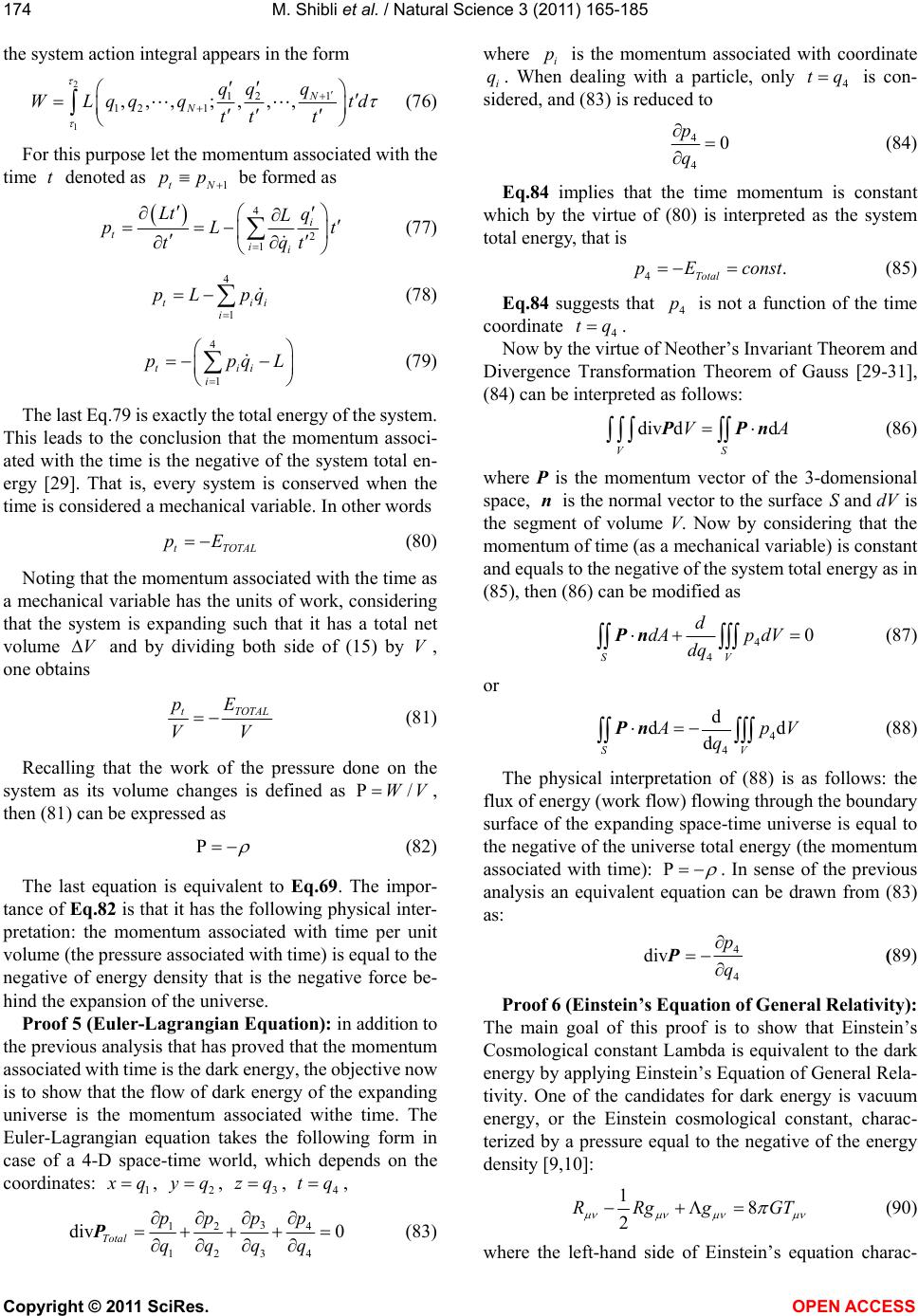 M. Shibli et al. / Natural Science 3 (2011) 165-185 Copyright © 2011 SciRes. OPEN ACCESS 174 the system action integral appears in the form 2 1 1 12 12 1 ,,,; ,,, N N q qq WLqq qtd tt t (76) For this purpose let the momentum associated with the time t denoted as 1tN pp be formed as 4 2 1 i t ii Lt q L pL t tq t (77) 4 1 tii i pL pq (78) 4 1 tii i ppqL (79) The last Eq.79 is exactly the total energy of the system. This leads to the conclusion that the momentum associ- ated with the time is the negative of the system total en- ergy [29]. That is, every system is conserved when the time is considered a mechanical variable. In other words tTOTAL pE (80) Noting that the momentum associated with the time as a mechanical variable has the units of work, considering that the system is expanding such that it has a total net volume V and by dividing both side of (15) by V, one obtains tTOTAL pE VV (81) Recalling that the work of the pressure done on the system as its volume changes is defined as /WV , then (81) can be expressed as (82) The last equation is equivalent to Eq.69. The impor- tance of Eq.82 is that it has the following physical inter- pretation: the momentum associated with time per unit volume (the pressure associated with time) is equal to the negative of energy density that is the negative force be- hind the expansion of the universe. Proof 5 (Euler-Lagrangian Equation): in addition to the previous analysis that has proved that the momentum associated with time is the dark energy, the objective now is to show that the flow of dark energy of the expanding universe is the momentum associated withe time. The Euler-Lagrangian equation takes the following form in case of a 4-D space-time world, which depends on the coordinates: 1 q, 2 yq, 3 zq, 4 tq, 3 12 4 1234 div 0 Total p pp p qqqq P (83) where i p is the momentum associated with coordinate i q. When dealing with a particle, only 4 tq is con- sidered, and (83) is reduced to 4 4 0 p q (84) Eq.84 implies that the time momentum is constant which by the virtue of (80) is interpreted as the system total energy, that is 4. Total pE const (85) Eq.84 suggests that 4 p is not a function of the time coordinate 4 tq . Now by the virtue of Neother’s Invariant Theorem and Divergence Transformation Theorem of Gauss [29-31], (84) can be interpreted as follows: div dd VS VA PPn (86) where P is the momentum vector of the 3-domensional space, n is the normal vector to the surface S and dV is the segment of volume V. Now by considering that the momentum of time (as a mechanical variable) is constant and equals to the negative of the system total energy as in (85), then (86) can be modified as 4 4 0 SV d dAp dV dq Pn (87) or 4 4 d dd d SV pV q Pn (88) The physical interpretation of (88) is as follows: the flux of energy (work flow) flowing through the boundary surface of the expanding space-time universe is equal to the negative of the universe total energy (the momentum associated with time): . In sense of the previous analysis an equivalent equation can be drawn from (83) as: 4 4 div p q P (89) Proof 6 (Einstein’s Equation of General Relativity): The main goal of this proof is to show that Einstein’s Cosmological constant Lambda is equivalent to the dark energy by applying Einstein’s Equation of General Rela- tivity. One of the candidates for dark energy is vacuum energy, or the Einstein cosmological constant, charac- terized by a pressure equal to the negative of the energy density [9,10]: 18 2 RRgg GT (90) where the left-hand side of Einstein’s equation charac- 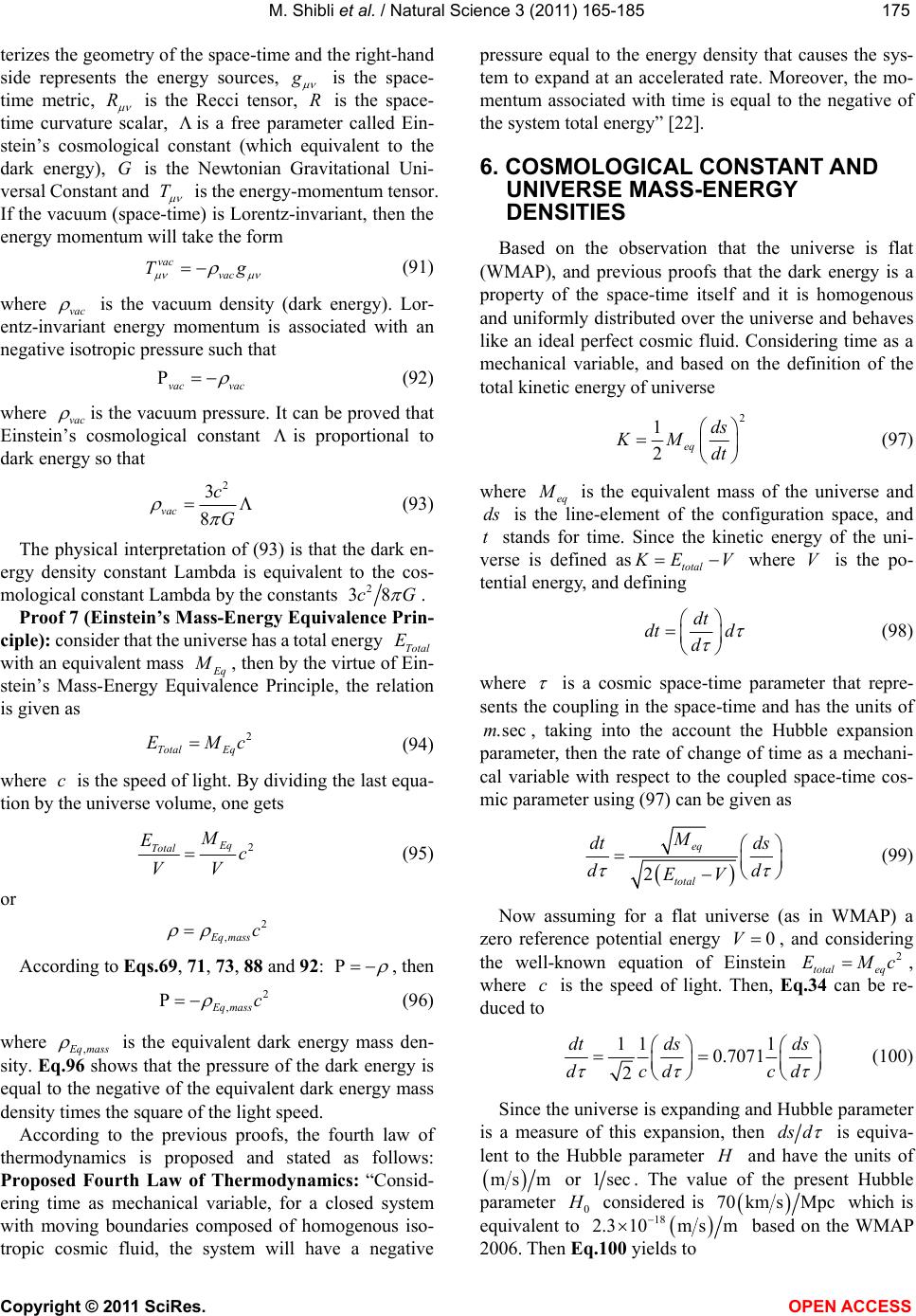 M. Shibli et al. / Natural Science 3 (2011) 165-185 Copyright © 2011 SciRes. OPEN ACCESS 175175 terizes the geometry of the space-time and the right-hand side represents the energy sources, is the space- time metric, R is the Recci tensor, R is the space- time curvature scalar, is a free parameter called Ein- stein’s cosmological constant (which equivalent to the dark energy), G is the Newtonian Gravitational Uni- versal Constant and T is the energy-momentum tensor. If the vacuum (space-time) is Lorentz-invariant, then the energy momentum will take the form vac vac Tg (91) where vac is the vacuum density (dark energy). Lor- entz-invariant energy momentum is associated with an negative isotropic pressure such that vac vac (92) where vac is the vacuum pressure. It can be proved that Einstein’s cosmological constant is proportional to dark energy so that 2 3 8 vac c G (93) The physical interpretation of (93) is that the dark en- ergy density constant Lambda is equivalent to the cos- mological constant Lambda by the constants 2 38cG . Proof 7 (Einstein’s Mass-Energy Equivalence Prin- ciple): consider that the universe has a total energy Total E with an equivalent mass q , then by the virtue of Ein- stein’s Mass-Energy Equivalence Principle, the relation is given as 2 Total Eq EMc (94) where c is the speed of light. By dividing the last equa- tion by the universe volume, one gets 2 Eq Total M Ec VV (95) or 2 , Eqmass c According to Eqs.69, 71, 73, 88 and 92: , then 2 , Eqmass c (96) where , qmass is the equivalent dark energy mass den- sity. Eq.96 shows that the pressure of the dark energy is equal to the negative of the equivalent dark energy mass density times the square of the light speed. According to the previous proofs, the fourth law of thermodynamics is proposed and stated as follows: Proposed Fourth Law of Thermodynamics: “Consid- ering time as mechanical variable, for a closed system with moving boundaries composed of homogenous iso- tropic cosmic fluid, the system will have a negative pressure equal to the energy density that causes the sys- tem to expand at an accelerated rate. Moreover, the mo- mentum associated with time is equal to the negative of the system total energy” [22]. 6. COSMOLOGICAL CONSTANT AND UNIVERSE MASS-ENERGY DENSITIES Based on the observation that the universe is flat (WMAP), and previous proofs that the dark energy is a property of the space-time itself and it is homogenous and uniformly distributed over the universe and behaves like an ideal perfect cosmic fluid. Considering time as a mechanical variable, and based on the definition of the total kinetic energy of universe 2 1 2eq ds KM dt (97) where eq is the equivalent mass of the universe and ds is the line-element of the configuration space, and t stands for time. Since the kinetic energy of the uni- verse is defined astotal EV where V is the po- tential energy, and defining dt dt d d (98) where is a cosmic space-time parameter that repre- sents the coupling in the space-time and has the units of .secm, taking into the account the Hubble expansion parameter, then the rate of change of time as a mechani- cal variable with respect to the coupled space-time cos- mic parameter using (97) can be given as 2 eq total M dt ds dd EV (99) Now assuming for a flat universe (as in WMAP) a zero reference potential energy 0V, and considering the well-known equation of Einstein 2 totaleq EMc, where c is the speed of light. Then, Eq.34 can be re- duced to 11 1 0.7071 2 dt dsds dcd cd (100) Since the universe is expanding and Hubble parameter is a measure of this expansion, then ds d is equiva- lent to the Hubble parameter and have the units of msm or 1sec. The value of the present Hubble parameter 0 considered is 70kmsMpc which is equivalent to 18 2.310m sm based on the WMAP 2006. Then Eq.10 0 yields to 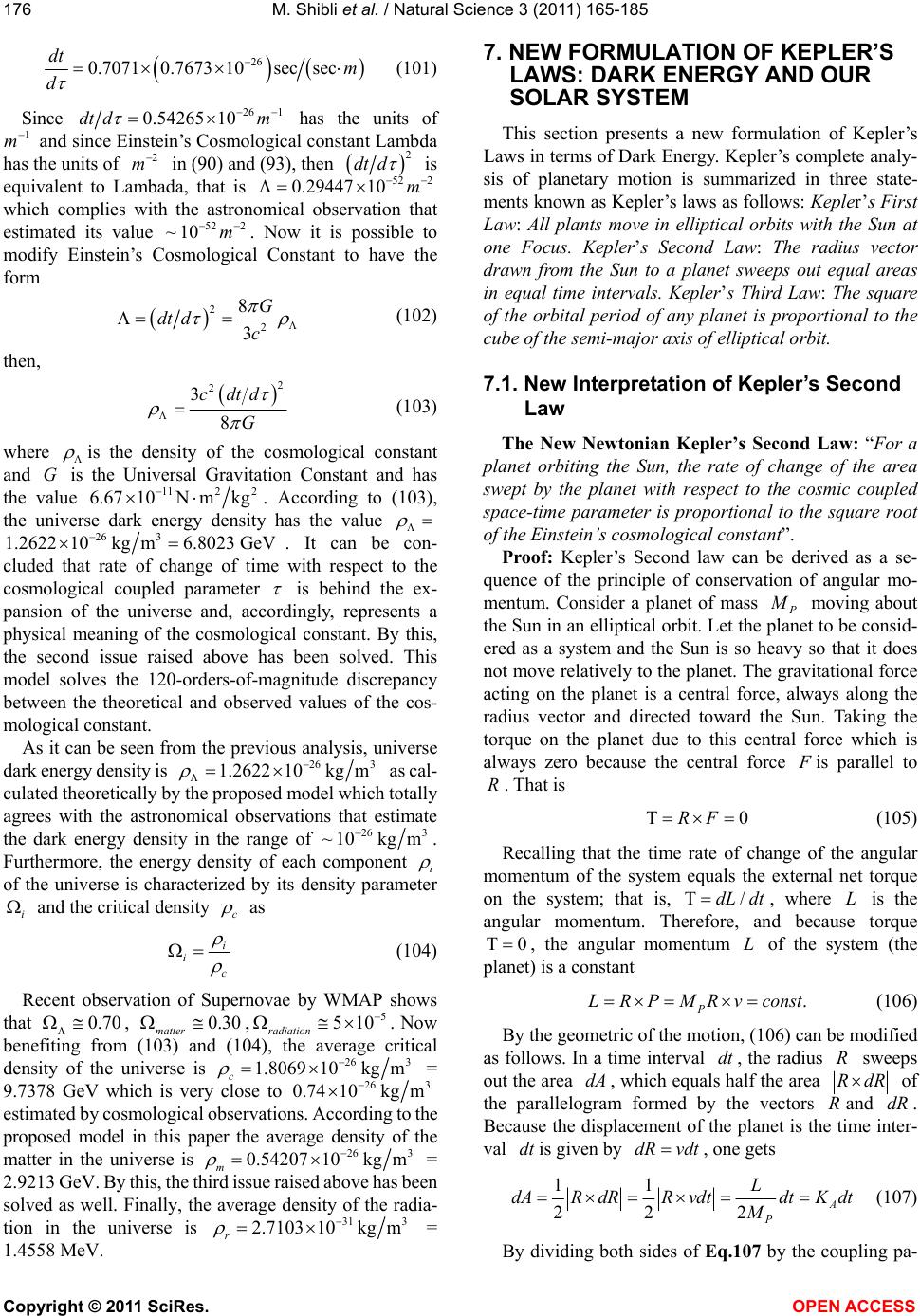 M. Shibli et al. / Natural Science 3 (2011) 165-185 Copyright © 2011 SciRes. OPEN ACCESS 176 26 0.70710.7673 10secsec dt m d (101) Since 26 1 0.5426510dt dm has the units of 1 m and since Einstein’s Cosmological constant Lambda has the units of 2 m in (90) and (93), then 2 dt d is equivalent to Lambada, that is 52 2 0.29447 10m which complies with the astronomical observation that estimated its value 52 2 ~10 m . Now it is possible to modify Einstein’s Cosmological Constant to have the form 2 2 8 3 G dt dc (102) then, 2 2 3 8 cdtd G (103) where is the density of the cosmological constant and G is the Universal Gravitation Constant and has the value 1122 6.6710N mkg . According to (103), the universe dark energy density has the value 26 3 1.262210kgm6.8023 GeV . It can be con- cluded that rate of change of time with respect to the cosmological coupled parameter is behind the ex- pansion of the universe and, accordingly, represents a physical meaning of the cosmological constant. By this, the second issue raised above has been solved. This model solves the 120-orders-of-magnitude discrepancy between the theoretical and observed values of the cos- mological constant. As it can be seen from the previous analysis, universe dark energy density is 26 3 1.262210kg m as cal- culated theoretically by the proposed model which totally agrees with the astronomical observations that estimate the dark energy density in the range of 26 3 ~10kgm . Furthermore, the energy density of each component i of the universe is characterized by its density parameter i and the critical density c as i i c (104) Recent observation of Supernovae by WMAP shows that 0.70 , 0.30 matter ,5 510 radiation . Now benefiting from (103) and (104), the average critical density of the universe is 26 3 1.806910kg m c = 9.7378 GeV which is very close to 26 3 0.7410kg m estimated by cosmological observations. According to the proposed model in this paper the average density of the matter in the universe is 26 3 0.5420710kgm m = 2.9213 GeV. By this, the third issue raised above has been solved as well. Finally, the average density of the radia- tion in the universe is 31 3 2.710310kg m r = 1.4558 MeV. 7. NEW FORMULATION OF KEPLER’S LAWS: DARK ENERGY AND OUR SOLAR SYSTEM This section presents a new formulation of Kepler’s Laws in terms of Dark Energy. Kepler’s complete analy- sis of planetary motion is summarized in three state- ments known as Kepler’s laws as follows: Kepl er’s First Law: All plants move in elliptical orbits with the Sun at one Focus. Keple r ’s Second Law: The radius vector drawn from the Sun to a planet sweeps out equal areas in equal time intervals. Kepler’s Third Law: The square of the orbital period of any planet is proportional to the cube of the semi-major axis of elliptical orbit. 7.1. New Interpretation of Kepler’s Second Law The New Newtonian Kepler’s Second Law: “For a planet orbiting the Sun, the rate of change of the area swept by the planet with respect to the cosmic coupled space-time parameter is proportional to the square root of the Einstein’s cosmological constant”. Proof: Kepler’s Second law can be derived as a se- quence of the principle of conservation of angular mo- mentum. Consider a planet of mass moving about the Sun in an elliptical orbit. Let the planet to be consid- ered as a system and the Sun is so heavy so that it does not move relatively to the planet. The gravitational force acting on the planet is a central force, always along the radius vector and directed toward the Sun. Taking the torque on the planet due to this central force which is always zero because the central force is parallel to R. That is 0RF (105) Recalling that the time rate of change of the angular momentum of the system equals the external net torque on the system; that is, /dLdt , where L is the angular momentum. Therefore, and because torque 0 , the angular momentum L of the system (the planet) is a constant . P LRPMRvconst (106) By the geometric of the motion, (106) can be modified as follows. In a time interval dt, the radius R sweeps out the area dA , which equals half the area RdR of the parallelogram formed by the vectors Rand dR. Because the displacement of the planet is the time inter- val dt is given by dR vdt , one gets 11 22 2A P L dARdRRvdtdtKdt M (107) By dividing both sides of Eq.107 by the coupling pa- 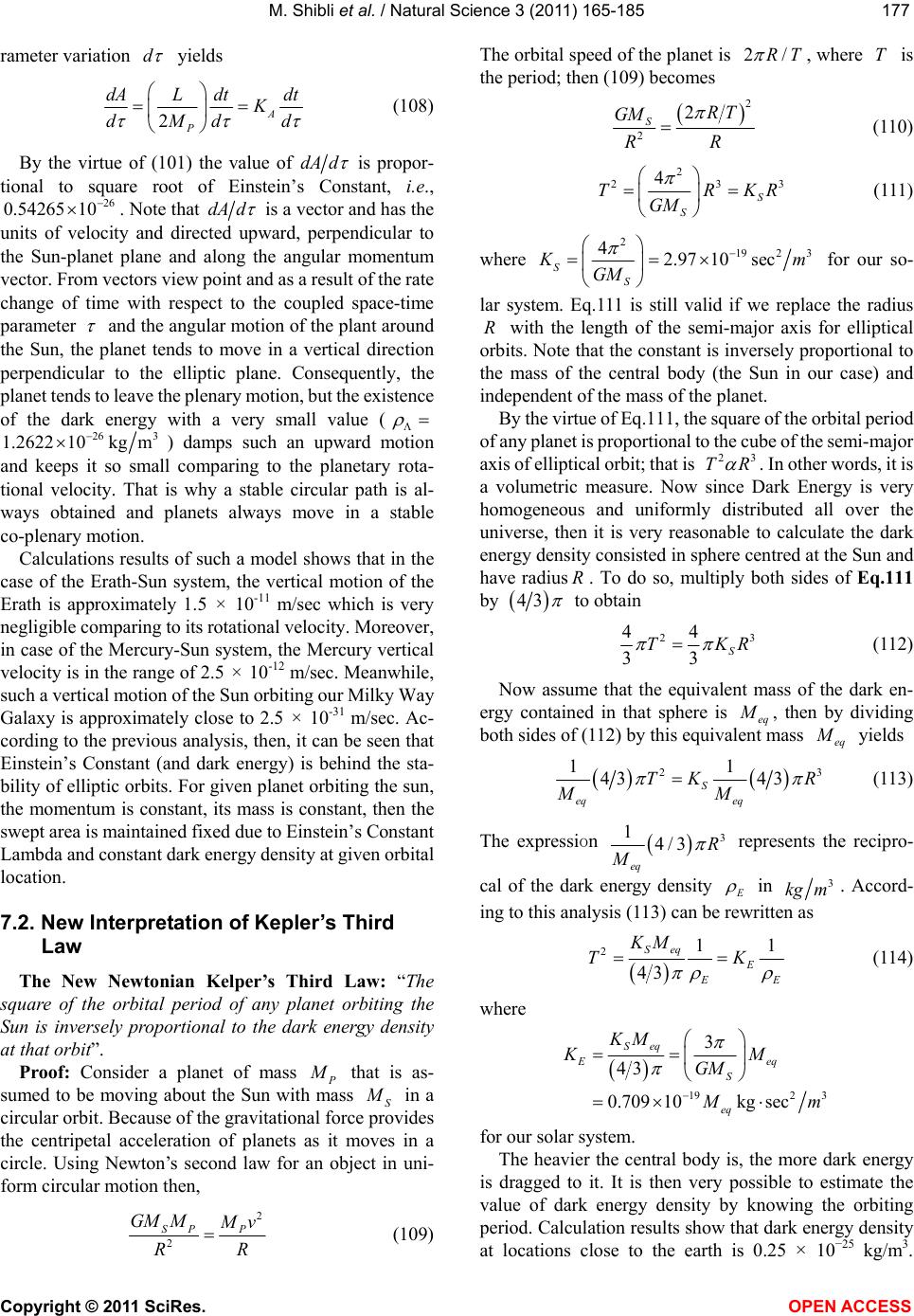 M. Shibli et al. / Natural Science 3 (2011) 165-185 Copyright © 2011 SciRes. OPEN ACCESS 177177 rameter variation d yields 2A P dALdtdt K dMd d (108) By the virtue of (101) the value of dA d is propor- tional to square root of Einstein’s Constant, i.e., 26 0.54265 10 . Note that dAd is a vector and has the units of velocity and directed upward, perpendicular to the Sun-planet plane and along the angular momentum vector. From vectors view point and as a result of the rate change of time with respect to the coupled space-time parameter and the angular motion of the plant around the Sun, the planet tends to move in a vertical direction perpendicular to the elliptic plane. Consequently, the planet tends to leave the plenary motion, but the existence of the dark energy with a very small value ( 26 3 1.262210kg m ) damps such an upward motion and keeps it so small comparing to the planetary rota- tional velocity. That is why a stable circular path is al- ways obtained and planets always move in a stable co-plenary motion. Calculations results of such a model shows that in the case of the Erath-Sun system, the vertical motion of the Erath is approximately 1.5 × 10-11 m/sec which is very negligible comparing to its rotational velocity. Moreover, in case of the Mercury-Sun system, the Mercury vertical velocity is in the range of 2.5 × 10-12 m/sec. Meanwhile, such a vertical motion of the Sun orbiting our Milky Way Galaxy is approximately close to 2.5 × 10-31 m/sec. Ac- cording to the previous analysis, then, it can be seen that Einstein’s Constant (and dark energy) is behind the sta- bility of elliptic orbits. For given planet orbiting the sun, the momentum is constant, its mass is constant, then the swept area is maintained fixed due to Einstein’s Constant Lambda and constant dark energy density at given orbital location. 7.2. New Interpretation of Kepler’s Third Law The New Newtonian Kelper’s Third Law: “The square of the orbital period of any planet orbiting the Sun is inversely proportional to the dark energy density at that orbit”. Proof: Consider a planet of mass that is as- sumed to be moving about the Sun with mass S in a circular orbit. Because of the gravitational force provides the centripetal acceleration of planets as it moves in a circle. Using Newton’s second law for an object in uni- form circular motion then, 2 2 SP P GM M v R R (109) The orbital speed of the planet is 2/RT , where T is the period; then (109) becomes 2 2 2 SRT GM R R (110) 2 233 4 S S TRKR GM (111) where 2 192 3 42.97 10sec S S m GM for our so- lar system. Eq.111 is still valid if we replace the radius R with the length of the semi-major axis for elliptical orbits. Note that the constant is inversely proportional to the mass of the central body (the Sun in our case) and independent of the mass of the planet. By the virtue of Eq.111, the square of the orbital period of any planet is proportional to the cube of the semi-major axis of elliptical orbit; that is 23 TR . In other words, it is a volumetric measure. Now since Dark Energy is very homogeneous and uniformly distributed all over the universe, then it is very reasonable to calculate the dark energy density consisted in sphere centred at the Sun and have radiusR. To do so, multiply both sides of Eq.11 1 by 43 to obtain 23 44 33 S TKR (112) Now assume that the equivalent mass of the dark en- ergy contained in that sphere is eq , then by dividing both sides of (112) by this equivalent mass eq yields 23 11 43 43 S eq eq TK R MM (113) The expression 3 14/3 eq R M represents the recipro- cal of the dark energy density in 3 kg m. Accord- ing to this analysis (113) can be rewritten as 211 43 Seq E E KM TK (114) where 192 3 3 43 0.70910kg sec Seq Eeq S eq KM KM GM m for our solar system. The heavier the central body is, the more dark energy is dragged to it. It is then very possible to estimate the value of dark energy density by knowing the orbiting period. Calculation results show that dark energy density at locations close to the earth is 0.25 × 10−25 kg/m3. 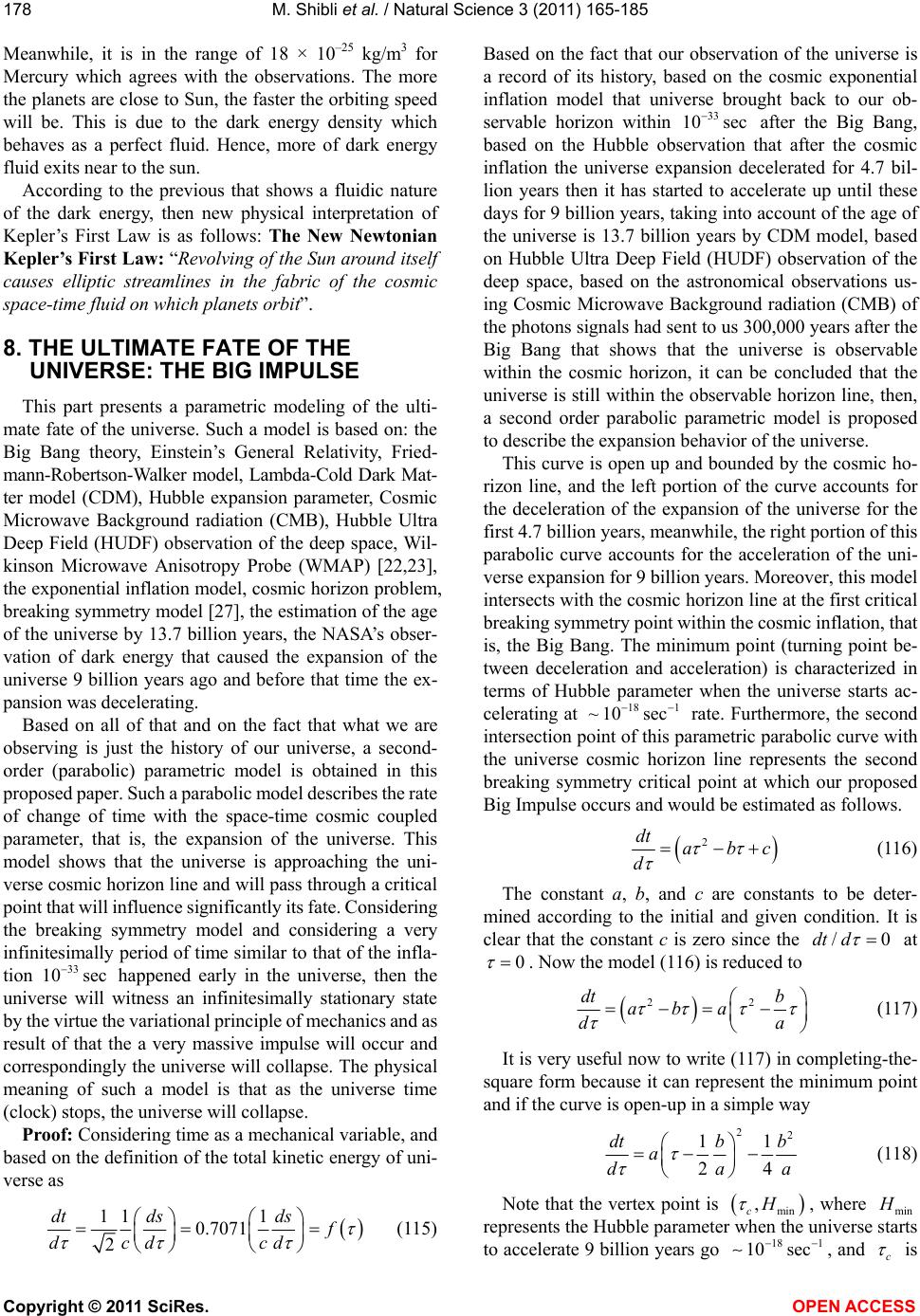 M. Shibli et al. / Natural Science 3 (2011) 165-185 Copyright © 2011 SciRes. OPEN ACCESS 178 Meanwhile, it is in the range of 18 × 10–25 kg/m3 for Mercury which agrees with the observations. The more the planets are close to Sun, the faster the orbiting speed will be. This is due to the dark energy density which behaves as a perfect fluid. Hence, more of dark energy fluid exits near to the sun. According to the previous that shows a fluidic nature of the dark energy, then new physical interpretation of Kepler’s First Law is as follows: The New Newtonian Kepler’s First Law: “Revolving of the Sun around itself causes elliptic streamlines in the fabric of the cosmic space-time fluid on which planets orbit”. 8. THE ULTIMATE FATE OF THE UNIVERSE: THE BIG IMPULSE This part presents a parametric modeling of the ulti- mate fate of the universe. Such a model is based on: the Big Bang theory, Einstein’s General Relativity, Fried- mann-Robertson-Walker model, Lambda-Cold Dark Mat- ter model (CDM), Hubble expansion parameter, Cosmic Microwave Background radiation (CMB), Hubble Ultra Deep Field (HUDF) observation of the deep space, Wil- kinson Microwave Anisotropy Probe (WMAP) [22,23], the exponential inflation model, cosmic horizon problem, breaking symmetry model [27], the estimation of the age of the universe by 13.7 billion years, the NASA’s obser- vation of dark energy that caused the expansion of the universe 9 billion years ago and before that time the ex- pansion was decelerating. Based on all of that and on the fact that what we are observing is just the history of our universe, a second- order (parabolic) parametric model is obtained in this proposed paper. Such a parabolic model describes the rate of change of time with the space-time cosmic coupled parameter, that is, the expansion of the universe. This model shows that the universe is approaching the uni- verse cosmic horizon line and will pass through a critical point that will influence significantly its fate. Considering the breaking symmetry model and considering a very infinitesimally period of time similar to that of the infla- tion 33 10 sec happened early in the universe, then the universe will witness an infinitesimally stationary state by the virtue the variational principle of mechanics and as result of that the a very massive impulse will occur and correspondingly the universe will collapse. The physical meaning of such a model is that as the universe time (clock) stops, the universe will collapse. Proof: Considering time as a mechanical variable, and based on the definition of the total kinetic energy of uni- verse as 11 1 0.7071 2 dtdsds f dcd cd (115) Based on the fact that our observation of the universe is a record of its history, based on the cosmic exponential inflation model that universe brought back to our ob- servable horizon within 33 10 sec after the Big Bang, based on the Hubble observation that after the cosmic inflation the universe expansion decelerated for 4.7 bil- lion years then it has started to accelerate up until these days for 9 billion years, taking into account of the age of the universe is 13.7 billion years by CDM model, based on Hubble Ultra Deep Field (HUDF) observation of the deep space, based on the astronomical observations us- ing Cosmic Microwave Background radiation (CMB) of the photons signals had sent to us 300,000 years after the Big Bang that shows that the universe is observable within the cosmic horizon, it can be concluded that the universe is still within the observable horizon line, then, a second order parabolic parametric model is proposed to describe the expansion behavior of the universe. This curve is open up and bounded by the cosmic ho- rizon line, and the left portion of the curve accounts for the deceleration of the expansion of the universe for the first 4.7 billion years, meanwhile, the right portion of this parabolic curve accounts for the acceleration of the uni- verse expansion for 9 billion years. Moreover, this model intersects with the cosmic horizon line at the first critical breaking symmetry point within the cosmic inflation, that is, the Big Bang. The minimum point (turning point be- tween deceleration and acceleration) is characterized in terms of Hubble parameter when the universe starts ac- celerating at 18 1 ~10 sec rate. Furthermore, the second intersection point of this parametric parabolic curve with the universe cosmic horizon line represents the second breaking symmetry critical point at which our proposed Big Impulse occurs and would be estimated as follows. 2 dt abc d (116) The constant a, b, and c are constants to be deter- mined according to the initial and given condition. It is clear that the constant c is zero since the /0dt d at 0 . Now the model (116) is reduced to 22 dt b aba da (117) It is very useful now to write (117) in completing-the- square form because it can represent the minimum point and if the curve is open-up in a simple way 22 11 24 dtb b a daa (118) Note that the vertex point is min , cH , where mi n represents the Hubble parameter when the universe starts to accelerate 9 billion years go 18 1 10 sec , and c is 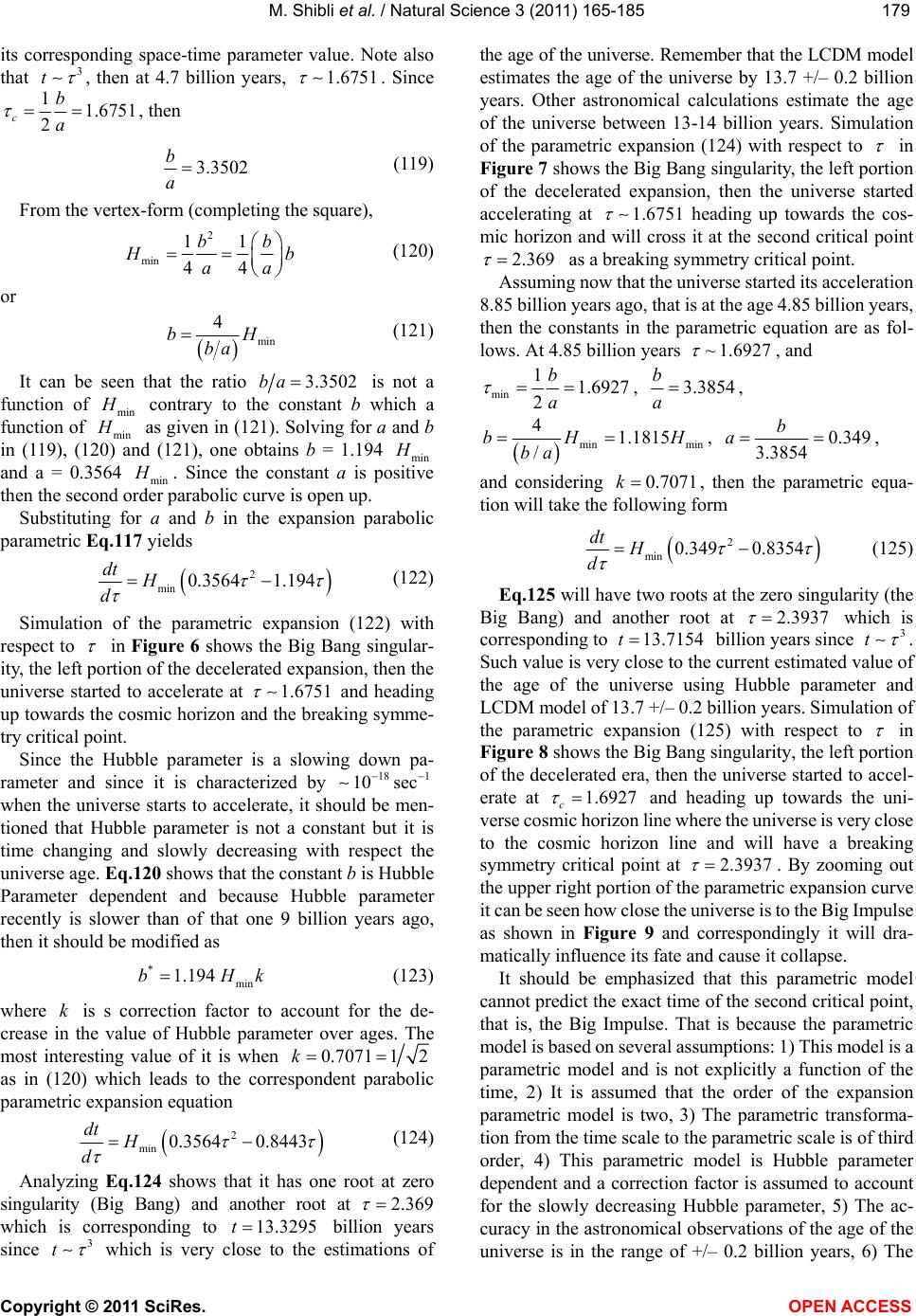 M. Shibli et al. / Natural Science 3 (2011) 165-185 Copyright © 2011 SciRes. OPEN ACCESS 179179 its corresponding space-time parameter value. Note also that 3 t , then at 4.7 billion years, 1.6751 . Since 11.6751 2 c b a , then 3.3502 b a (119) From the vertex-form (completing the square), 2 min 11 44 bb b aa (120) or min 4 bH ba (121) It can be seen that the ratio 3.3502ba is not a function of mi n contrary to the constant b which a function of min as given in (121). Solving for a and b in (119), (120) and (121), one obtains b = 1.194 mi n and a = 0.3564 min . Since the constant a is positive then the second order parabolic curve is open up. Substituting for a and b in the expansion parabolic parametric Eq.117 yields 2 min 0.3564 1.194 dt H d (122) Simulation of the parametric expansion (122) with respect to in Figure 6 shows the Big Bang singular- ity, the left portion of the decelerated expansion, then the universe started to accelerate at 1.6751 and heading up towards the cosmic horizon and the breaking symme- try critical point. Since the Hubble parameter is a slowing down pa- rameter and since it is characterized by 18 1 10 sec when the universe starts to accelerate, it should be men- tioned that Hubble parameter is not a constant but it is time changing and slowly decreasing with respect the universe age. Eq.120 shows that the constant b is Hubble Parameter dependent and because Hubble parameter recently is slower than of that one 9 billion years ago, then it should be modified as * min 1.194bHk (123) where k is s correction factor to account for the de- crease in the value of Hubble parameter over ages. The most interesting value of it is when 0.7071 12k as in (120) which leads to the correspondent parabolic parametric expansion equation 2 min 0.3564 0.8443 dt H d (124) Analyzing Eq.124 shows that it has one root at zero singularity (Big Bang) and another root at 2.369 which is corresponding to 13.3295t billion years since 3 t which is very close to the estimations of the age of the universe. Remember that the LCDM model estimates the age of the universe by 13.7 +/– 0.2 billion years. Other astronomical calculations estimate the age of the universe between 13-14 billion years. Simulation of the parametric expansion (124) with respect to in Figure 7 shows the Big Bang singularity, the left portion of the decelerated expansion, then the universe started accelerating at 1.6751 heading up towards the cos- mic horizon and will cross it at the second critical point 2.369 as a breaking symmetry critical point. Assuming now that the universe started its acceleration 8.85 billion years ago, that is at the age 4.85 billion years, then the constants in the parametric equation are as fol- lows. At 4.85 billion years ~1.6927 , and min 11.6927 2 b a , 3.3854 b a, min min 41.1815 / bH H ba , 0.349 3.3854 b a, and considering 0.7071k , then the parametric equa- tion will take the following form 2 min 0.349 0.8354 dt H d (125) Eq.125 will have two roots at the zero singularity (the Big Bang) and another root at 2.3937 which is corresponding to 13.7154t billion years since 3 t . Such value is very close to the current estimated value of the age of the universe using Hubble parameter and LCDM model of 13.7 +/– 0.2 billion years. Simulation of the parametric expansion (125) with respect to in Figure 8 shows the Big Bang singularity, the left portion of the decelerated era, then the universe started to accel- erate at 1.6927 c and heading up towards the uni- verse cosmic horizon line where the universe is very close to the cosmic horizon line and will have a breaking symmetry critical point at 2.3937 . By zooming out the upper right portion of the parametric expansion curve it can be seen how close the universe is to the Big Impulse as shown in Figure 9 and correspondingly it will dra- matically influence its fate and cause it collapse. It should be emphasized that this parametric model cannot predict the exact time of the second critical point, that is, the Big Impulse. That is because the parametric model is based on several assumptions: 1) This model is a parametric model and is not explicitly a function of the time, 2) It is assumed that the order of the expansion parametric model is two, 3) The parametric transforma- tion from the time scale to the parametric scale is of third order, 4) This parametric model is Hubble parameter dependent and a correction factor is assumed to account for the slowly decreasing Hubble parameter, 5) The ac- curacy in the astronomical observations of the age of the universe is in the range of +/– 0.2 billion years, 6) The 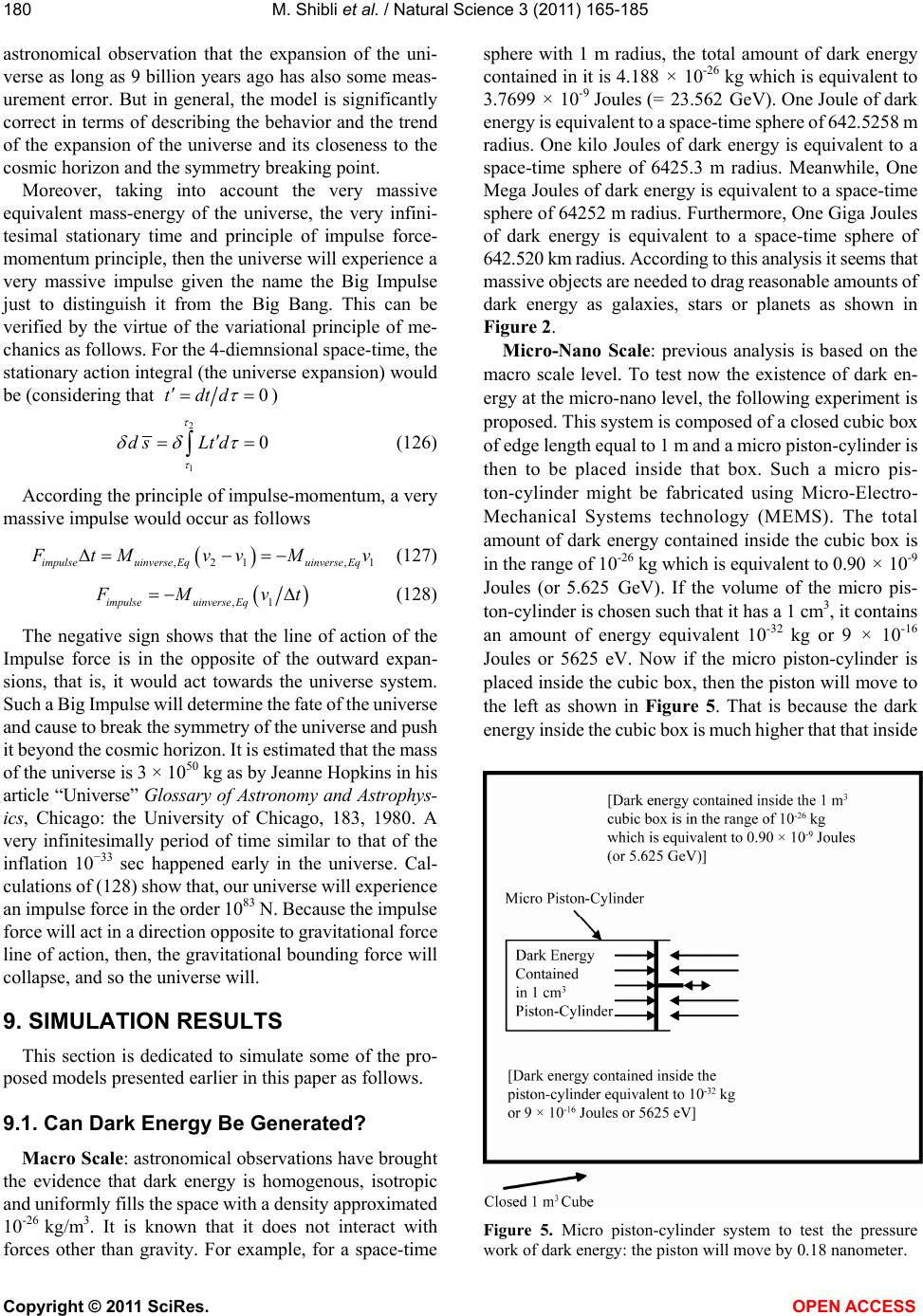 M. Shibli et al. / Natural Science 3 (2011) 165-185 Copyright © 2011 SciRes. OPEN ACCESS 180 astronomical observation that the expansion of the uni- verse as long as 9 billion years ago has also some meas- urement error. But in general, the model is significantly correct in terms of describing the behavior and the trend of the expansion of the universe and its closeness to the cosmic horizon and the symmetry breaking point. Moreover, taking into account the very massive equivalent mass-energy of the universe, the very infini- tesimal stationary time and principle of impulse force- momentum principle, then the universe will experience a very massive impulse given the name the Big Impulse just to distinguish it from the Big Bang. This can be verified by the virtue of the variational principle of me- chanics as follows. For the 4-diemnsional space-time, the stationary action integral (the universe expansion) would be (considering that 0tdtd ) 2 1 0ds Ltd (126) According the principle of impulse-momentum, a very massive impulse would occur as follows ,21 ,1impulseuinverse Equinverse Eq tMv vMv (127) ,1impulseuinverse Eq Mvt (128) The negative sign shows that the line of action of the Impulse force is in the opposite of the outward expan- sions, that is, it would act towards the universe system. Such a Big Impulse will determine the fate of the universe and cause to break the symmetry of the universe and push it beyond the cosmic horizon. It is estimated that the mass of the universe is 3 × 1050 kg as by Jeanne Hopkins in his article “Universe” Glossary of Astronomy and Astrophys- ics, Chicago: the University of Chicago, 183, 1980. A very infinitesimally period of time similar to that of the inflation 10−33 sec happened early in the universe. Cal- culations of (128) show that, our universe will experience an impulse force in the order 1083 N. Because the impulse force will act in a direction opposite to gravitational force line of action, then, the gravitational bounding force will collapse, and so the universe will. 9. SIMULATION RESULTS This section is dedicated to simulate some of the pro- posed models presented earlier in this paper as follows. 9.1. Can Dark Energy Be Generated? Macro Scale: astronomical observations have brought the evidence that dark energy is homogenous, isotropic and uniformly fills the space with a density approximated 10-26 kg/m3. It is known that it does not interact with forces other than gravity. For example, for a space-time sphere with 1 m radius, the total amount of dark energy contained in it is 4.188 × 10-26 kg which is equivalent to 3.7699 × 10-9 Joules (= 23.562 GeV). One Joule of dark energy is equivalent to a space-time sphere of 642.5258 m radius. One kilo Joules of dark energy is equivalent to a space-time sphere of 6425.3 m radius. Meanwhile, One Mega Joules of dark energy is equivalent to a space-time sphere of 64252 m radius. Furthermore, One Giga Joules of dark energy is equivalent to a space-time sphere of 642.520 km radius. According to this analysis it seems that massive objects are needed to drag reasonable amounts of dark energy as galaxies, stars or planets as shown in Figure 2. Micro-Nano Scale: previous analysis is based on the macro scale level. To test now the existence of dark en- ergy at the micro-nano level, the following experiment is proposed. This system is composed of a closed cubic box of edge length equal to 1 m and a micro piston-cylinder is then to be placed inside that box. Such a micro pis- ton-cylinder might be fabricated using Micro-Electro- Mechanical Systems technology (MEMS). The total amount of dark energy contained inside the cubic box is in the range of 10-26 kg which is equivalent to 0.90 × 10-9 Joules (or 5.625 GeV). If the volume of the micro pis- ton-cylinder is chosen such that it has a 1 cm3, it contains an amount of energy equivalent 10-32 kg or 9 × 10-16 Joules or 5625 eV. Now if the micro piston-cylinder is placed inside the cubic box, then the piston will move to the left as shown in Figure 5. That is because the dark energy inside the cubic box is much higher that that inside Figure 5. Micro piston-cylinder system to test the pressure work of dark energy: the piston will move by 0.18 nanometer. 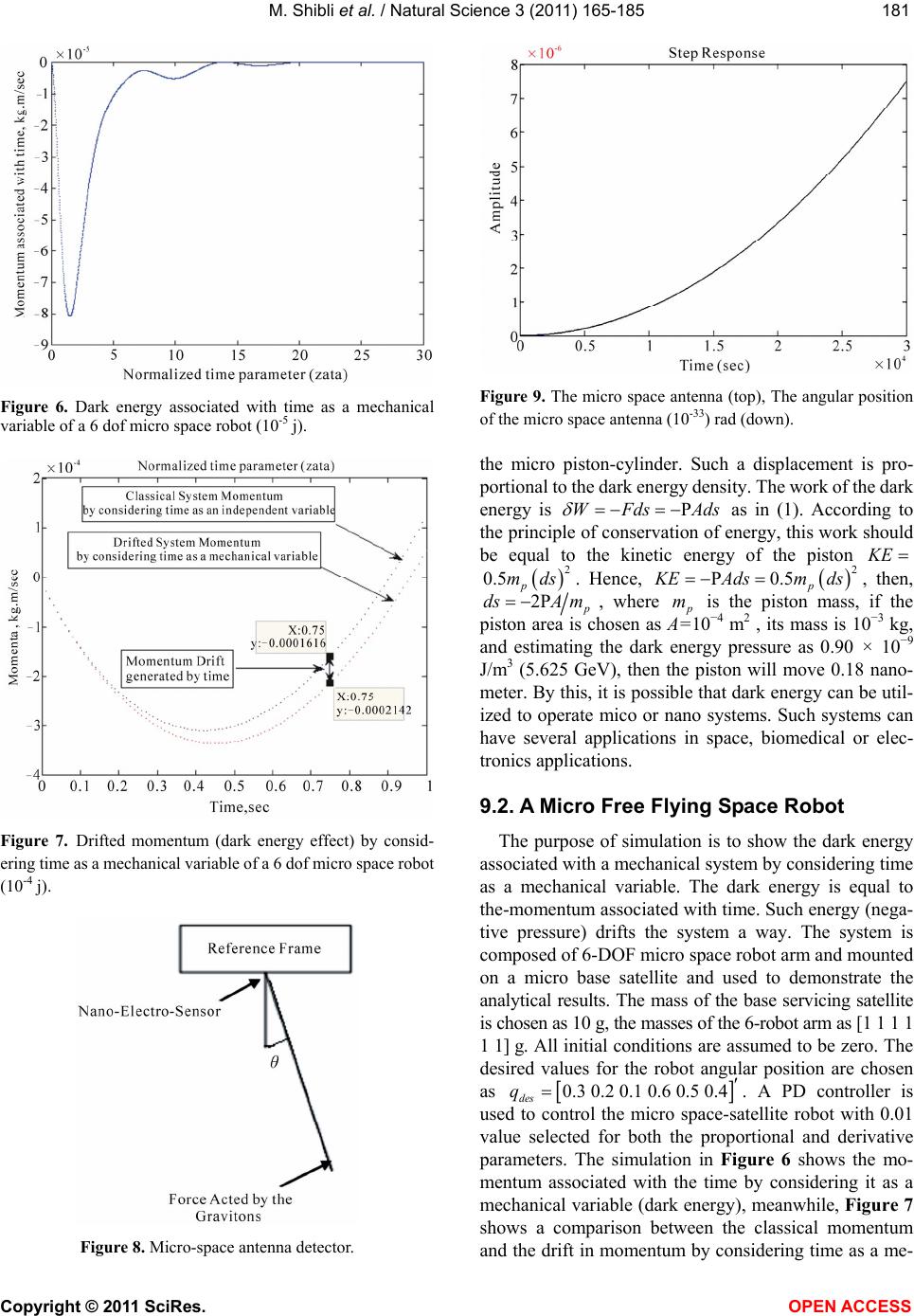 M. Shibli et al. / Natural Science 3 (2011) 165-185 Copyright © 2011 SciRes. OPEN ACCESS 181181 Figure 6. Dark energy associated with time as a mechanical variable of a 6 dof micro space robot (10-5 j). Figure 7. Drifted momentum (dark energy effect) by consid- ering time as a mechanical variable of a 6 dof micro space robot (10-4 j). Figure 8. Micro-space antenna detector. Figure 9. The micro space antenna (top), The angular position of the micro space antenna (10-33) rad (down). the micro piston-cylinder. Such a displacement is pro- portional to the dark energy density. The work of the dark energy is W FdsAds as in (1). According to the principle of conservation of energy, this work should be equal to the kinetic energy of the piston E 2 0.5 p mds. Hence, 2 0.5 p EAdsm ds , then, 2 dsA m , where m is the piston mass, if the piston area is chosen as A=10−4 m2 , its mass is 10−3 kg, and estimating the dark energy pressure as 0.90 × 10−9 J/m3 (5.625 GeV), then the piston will move 0.18 nano- meter. By this, it is possible that dark energy can be util- ized to operate mico or nano systems. Such systems can have several applications in space, biomedical or elec- tronics applications. 9.2. A Micro Free Flying Space Robot The purpose of simulation is to show the dark energy associated with a mechanical system by considering time as a mechanical variable. The dark energy is equal to the-momentum associated with time. Such energy (nega- tive pressure) drifts the system a way. The system is composed of 6-DOF micro space robot arm and mounted on a micro base satellite and used to demonstrate the analytical results. The mass of the base servicing satellite is chosen as 10 g, the masses of the 6-robot arm as [1 1 1 1 1 1] g. All initial conditions are assumed to be zero. The desired values for the robot angular position are chosen as 0.3 0.2 0.1 0.6 0.5 0.4 des q . A PD controller is used to control the micro space-satellite robot with 0.01 value selected for both the proportional and derivative parameters. The simulation in Figure 6 shows the mo- mentum associated with the time by considering it as a mechanical variable (dark energy), meanwhile, Figure 7 shows a comparison between the classical momentum and the drift in momentum by considering time as a me- 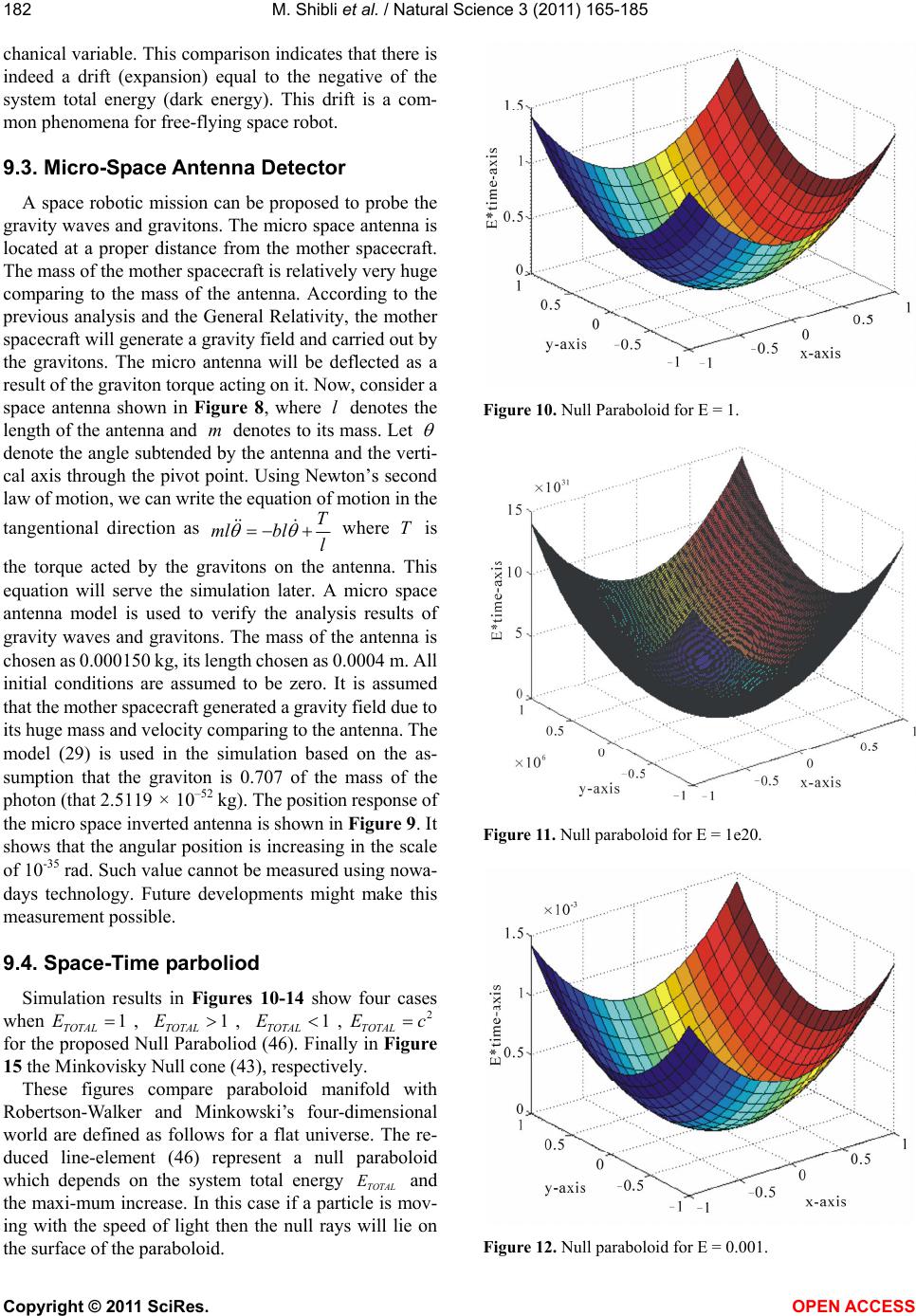 M. Shibli et al. / Natural Science 3 (2011) 165-185 Copyright © 2011 SciRes. OPEN ACCESS 182 chanical variable. This comparison indicates that there is indeed a drift (expansion) equal to the negative of the system total energy (dark energy). This drift is a com- mon phenomena for free-flying space robot. 9.3. Micro-Space Antenna Detector A space robotic mission can be proposed to probe the gravity waves and gravitons. The micro space antenna is located at a proper distance from the mother spacecraft. The mass of the mother spacecraft is relatively very huge comparing to the mass of the antenna. According to the previous analysis and the General Relativity, the mother spacecraft will generate a gravity field and carried out by the gravitons. The micro antenna will be deflected as a result of the graviton torque acting on it. Now, consider a space antenna shown in Figure 8, where l denotes the length of the antenna and m denotes to its mass. Let denote the angle subtended by the antenna and the verti- cal axis through the pivot point. Using Newton’s second law of motion, we can write the equation of motion in the tangentional direction as T mlbl l where T is the torque acted by the gravitons on the antenna. This equation will serve the simulation later. A micro space antenna model is used to verify the analysis results of gravity waves and gravitons. The mass of the antenna is chosen as 0.000150 kg, its length chosen as 0.0004 m. All initial conditions are assumed to be zero. It is assumed that the mother spacecraft generated a gravity field due to its huge mass and velocity comparing to the antenna. The model (29) is used in the simulation based on the as- sumption that the graviton is 0.707 of the mass of the photon (that 2.5119 × 10–52 kg). The position response of the micro space inverted antenna is shown in Figure 9. It shows that the angular position is increasing in the scale of 10-35 rad. Such value cannot be measured using nowa- days technology. Future developments might make this measurement possible. 9.4. Space-Time parboliod Simulation results in Figures 10-14 show four cases when 1 TOTAL E, 1 TOTAL E, 1 TOTAL E,2 TOTAL Ec for the proposed Null Paraboliod (46). Finally in Figure 15 the Minkovisky Null cone (43), respectively. These figures compare paraboloid manifold with Robertson-Walker and Minkowski’s four-dimensional world are defined as follows for a flat universe. The re- duced line-element (46) represent a null paraboloid which depends on the system total energy TOTAL E and the maxi-mum increase. In this case if a particle is mov- ing with the speed of light then the null rays will lie on the surface of the paraboloid. Figure 10. Null Paraboloid for E = 1. Figure 11. Null paraboloid for E = 1e20. Figure 12. Null paraboloid for E = 0.001. 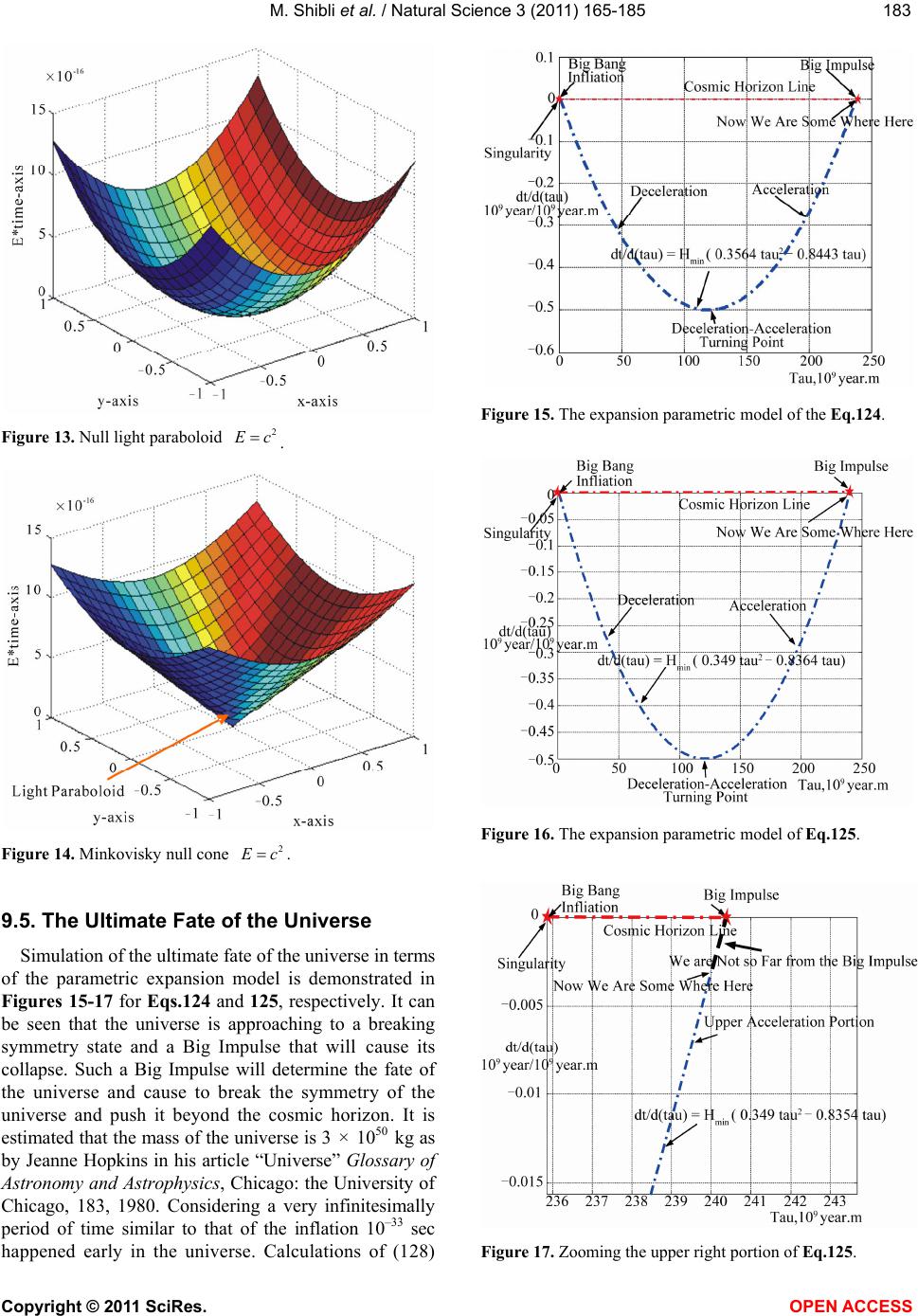 M. Shibli et al. / Natural Science 3 (2011) 165-185 Copyright © 2011 SciRes. OPEN ACCESS 183183 Figure 13. Null light paraboloid 2 Ec. Figure 14. Minkovisky null cone 2 Ec. 9.5. The Ultimate Fate of the Universe Simulation of the ultimate fate of the universe in terms of the parametric expansion model is demonstrated in Figures 15-17 for Eqs.124 and 125, respectively. It can be seen that the universe is approaching to a breaking symmetry state and a Big Impulse that will cause its collapse. Such a Big Impulse will determine the fate of the universe and cause to break the symmetry of the universe and push it beyond the cosmic horizon. It is estimated that the mass of the universe is 3 × 1050 kg as by Jeanne Hopkins in his article “Universe” Glossary of Astronomy and Astrophysics, Chicago: the University of Chicago, 183, 1980. Considering a very infinitesimally period of time similar to that of the inflation 10–33 sec happened early in the universe. Calculations of (128) Figure 15. The expansion parametric model of the Eq.124. Figure 16. The expansion parametric model of Eq.125. Figure 17. Zooming the upper right portion of Eq.125. 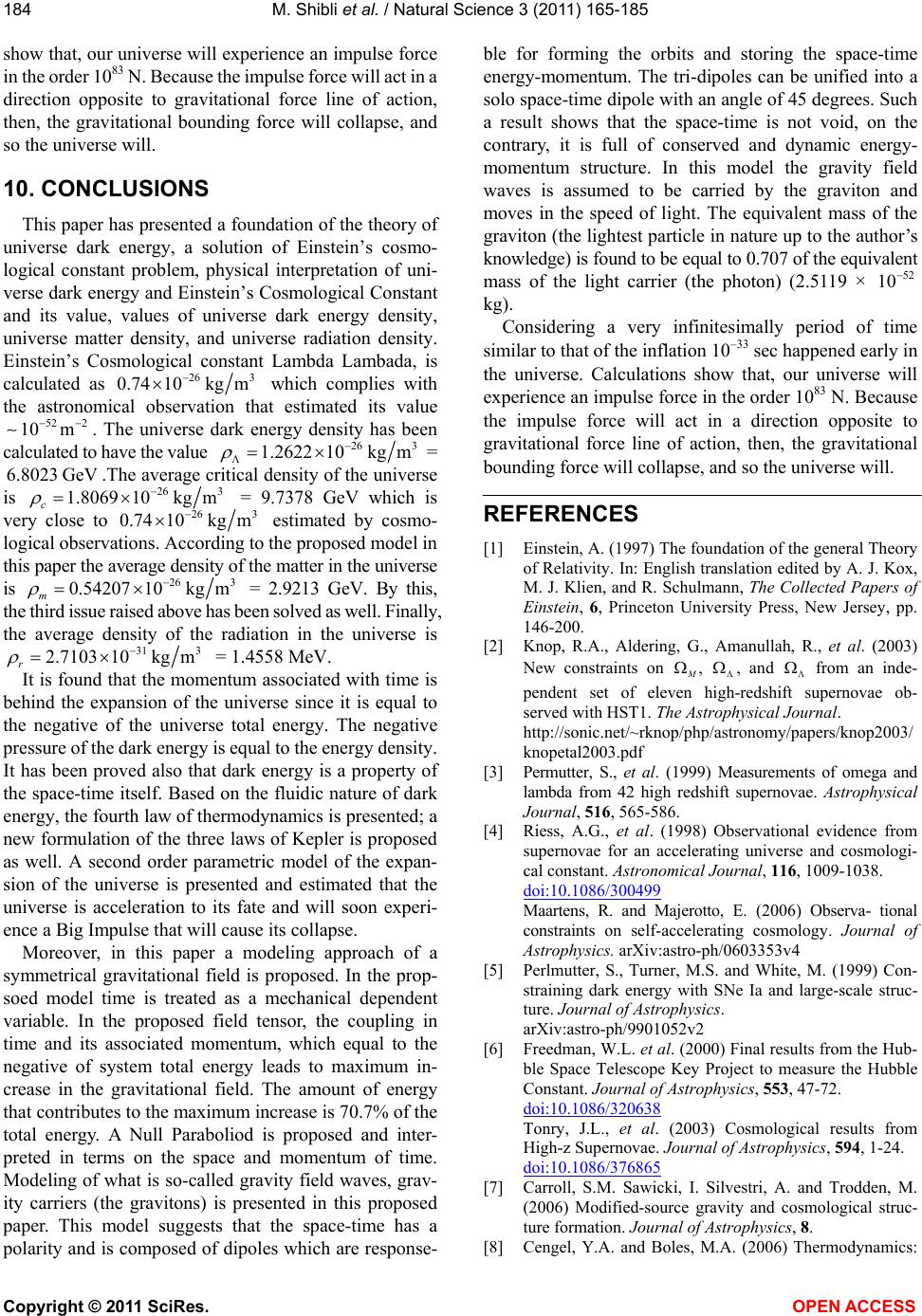 M. Shibli et al. / Natural Science 3 (2011) 165-185 Copyright © 2011 SciRes. OPEN ACCESS 184 show that, our universe will experience an impulse force in the order 1083 N. Because the impulse force will act in a direction opposite to gravitational force line of action, then, the gravitational bounding force will collapse, and so the universe will. 10. CONCLUSIONS This paper has presented a foundation of the theory of universe dark energy, a solution of Einstein’s cosmo- logical constant problem, physical interpretation of uni- verse dark energy and Einstein’s Cosmological Constant and its value, values of universe dark energy density, universe matter density, and universe radiation density. Einstein’s Cosmological constant Lambda Lambada, is calculated as 26 3 0.7410kg m which complies with the astronomical observation that estimated its value 52 2 10m . The universe dark energy density has been calculated to have the value 26 3 1.262210kg m = 6.8023 GeV.The average critical density of the universe is 26 3 1.806910kg m c = 9.7378 GeV which is very close to 26 3 0.7410kg m estimated by cosmo- logical observations. According to the proposed model in this paper the average density of the matter in the universe is 26 3 0.5420710kg m m = 2.9213 GeV. By this, the third issue raised above has been solved as well. Finally, the average density of the radiation in the universe is 31 3 2.710310kgm r = 1.4558 MeV. It is found that the momentum associated with time is behind the expansion of the universe since it is equal to the negative of the universe total energy. The negative pressure of the dark energy is equal to the energy density. It has been proved also that dark energy is a property of the space-time itself. Based on the fluidic nature of dark energy, the fourth law of thermodynamics is presented; a new formulation of the three laws of Kepler is proposed as well. A second order parametric model of the expan- sion of the universe is presented and estimated that the universe is acceleration to its fate and will soon experi- ence a Big Impulse that will cause its collapse. Moreover, in this paper a modeling approach of a symmetrical gravitational field is proposed. In the prop- soed model time is treated as a mechanical dependent variable. In the proposed field tensor, the coupling in time and its associated momentum, which equal to the negative of system total energy leads to maximum in- crease in the gravitational field. The amount of energy that contributes to the maximum increase is 70.7% of the total energy. A Null Paraboliod is proposed and inter- preted in terms on the space and momentum of time. Modeling of what is so-called gravity field waves, grav- ity carriers (the gravitons) is presented in this proposed paper. This model suggests that the space-time has a polarity and is composed of dipoles which are response- ble for forming the orbits and storing the space-time energy-momentum. The tri-dipoles can be unified into a solo space-time dipole with an angle of 45 degrees. Such a result shows that the space-time is not void, on the contrary, it is full of conserved and dynamic energy- momentum structure. In this model the gravity field waves is assumed to be carried by the graviton and moves in the speed of light. The equivalent mass of the graviton (the lightest particle in nature up to the author’s knowledge) is found to be equal to 0.707 of the equivalent mass of the light carrier (the photon) (2.5119 × 52 10 kg). Considering a very infinitesimally period of time similar to that of the inflation 10–33 sec happened early in the universe. Calculations show that, our universe will experience an impulse force in the order 1083 N. Because the impulse force will act in a direction opposite to gravitational force line of action, then, the gravitational bounding force will collapse, and so the universe will. REFERENCES [1] Einstein, A. (1997) The foundation of the general Theory of Relativity. In: English translation edited by A. J. Kox, M. J. Klien, and R. Schulmann, The Collected Papers of Einstein, 6, Princeton University Press, New Jersey, pp. 146-200. [2] Knop, R.A., Aldering, G., Amanullah, R., et al. (2003) New constraints on , , and from an inde- pendent set of eleven high-redshift supernovae ob- served with HST1. The Astrophysical Journal. http://sonic.net/~rknop/php/astronomy/papers/knop2003/ knopetal2003.pdf [3] Permutter, S., et al. (1999) Measurements of omega and lambda from 42 high redshift supernovae. Astrophysical Journal, 516, 565-586. [4] Riess, A.G., et al. (1998) Observational evidence from supernovae for an accelerating universe and cosmologi- cal constant. Astronomical Journal, 116, 1009-1038. doi:10.1086/300499 Maartens, R. and Majerotto, E. (2006) Observa- tional constraints on self-accelerating cosmology. Journal of Astrophysics. arXiv:astro-ph/0603353v4 [5] Perlmutter, S., Turner, M.S. and White, M. (1999) Con- straining dark energy with SNe Ia and large-scale struc- ture. Journal of Astrophysics. arXiv:astro-ph/9901052v2 [6] Freedman, W.L. et al. (2000) Final results from the Hub- ble Space Telescope Key Project to measure the Hubble Constant. Journal of Astrophysics, 553, 47-72. doi:10.1086/320638 Tonry, J.L., et al. (2003) Cosmological results from High-z Supernovae. Journal of Astrophysics, 594, 1-24. doi:10.1086/376865 [7] Carroll, S.M. Sawicki, I. Silvestri, A. and Trodden, M. (2006) Modified-source gravity and cosmological struc- ture formation. Journal of Astrophysics, 8. [8] Cengel, Y.A. and Boles, M.A. (2006) Thermodynamics: 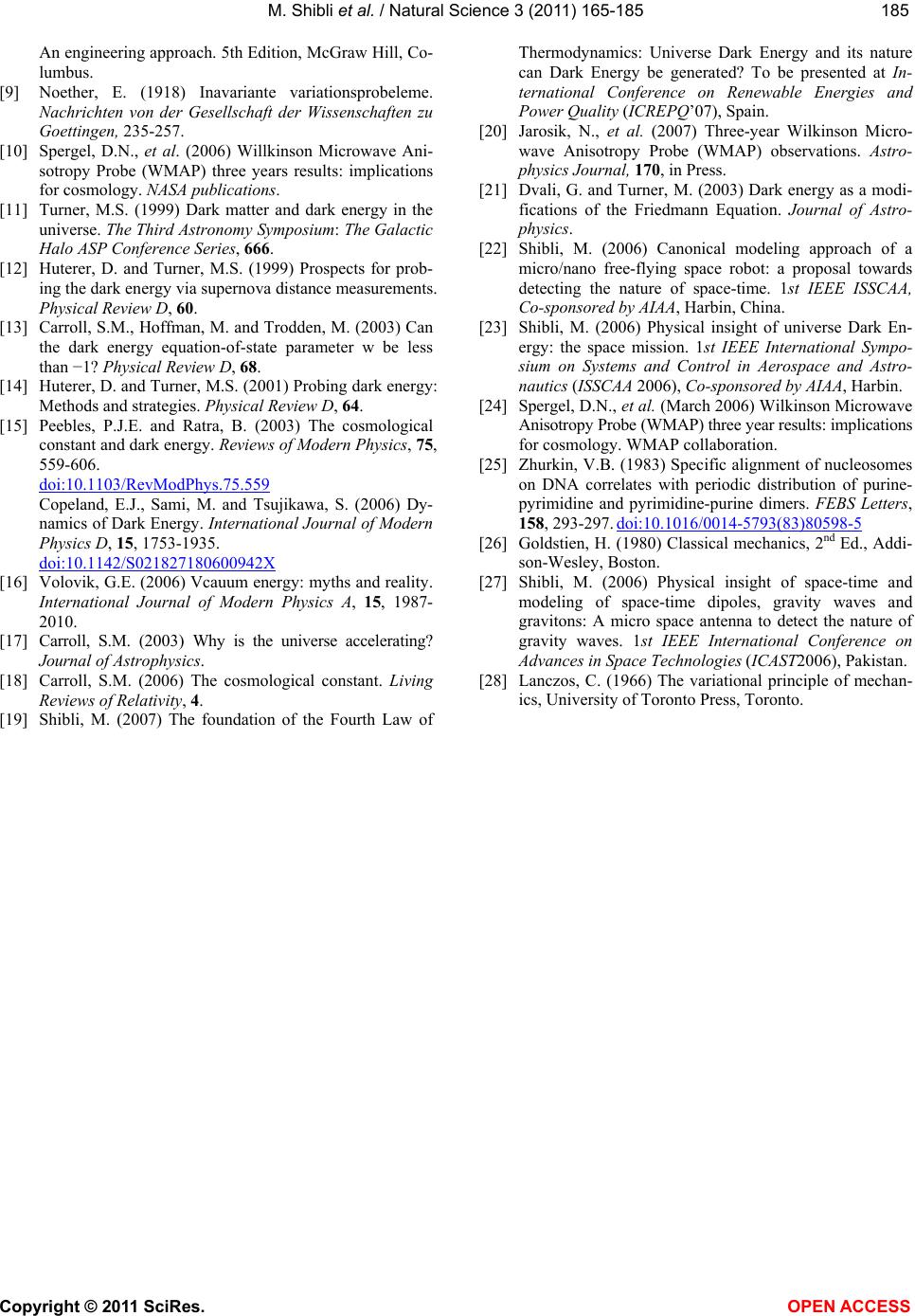 M. Shibli et al. / Natural Science 3 (2011) 165-185 Copyright © 2011 SciRes. OPEN ACCESS 185185 An engineering approach. 5th Edition, McGraw Hill, Co- lumbus. [9] Noether, E. (1918) Inavariante variationsprobeleme. Nachrichten von der Gesellschaft der Wissenschaften zu Goettingen, 235-257. [10] Spergel, D.N., et al. (2006) Willkinson Microwave Ani- sotropy Probe (WMAP) three years results: implications for cosmology. NASA publications. [11] Turner, M.S. (1999) Dark matter and dark energy in the universe. The Third Astronomy Symposium: The Galactic Halo ASP Conference Series, 666. [12] Huterer, D. and Turner, M.S. (1999) Prospects for prob- ing the dark energy via supernova distance measurements. Physical Review D, 60. [13] Carroll, S.M., Hoffman, M. and Trodden, M. (2003) Can the dark energy equation-of-state parameter w be less than −1? Physical Review D, 68. [14] Huterer, D. and Turner, M.S. (2001) Probing dark energy: Methods and strategies. Physical Review D, 64. [15] Peebles, P.J.E. and Ratra, B. (2003) The cosmological constant and dark energy. Reviews of Modern Physics, 75, 559-606. doi:10.1103/RevModPhys.75.559 Copeland, E.J., Sami, M. and Tsujikawa, S. (2006) Dy- namics of Dark Energy. International Journal of Modern Physics D, 15, 1753-1935. doi:10.1142/S021827180600942X [16] Volovik, G.E. (2006) Vcauum energy: myths and reality. International Journal of Modern Physics A, 15, 1987- 2010. [17] Carroll, S.M. (2003) Why is the universe accelerating? Journal of Astrophysics. [18] Carroll, S.M. (2006) The cosmological constant. Living Reviews of Relativity, 4. [19] Shibli, M. (2007) The foundation of the Fourth Law of Thermodynamics: Universe Dark Energy and its nature can Dark Energy be generated? To be presented at In- ternational Conference on Renewable Energies and Power Quality (ICREPQ’07), Spain. [20] Jarosik, N., et al. (2007) Three-year Wilkinson Micro- wave Anisotropy Probe (WMAP) observations. Astro- physics Journal, 170, in Press. [21] Dvali, G. and Turner, M. (2003) Dark energy as a modi- fications of the Friedmann Equation. Journal of Astro- physics. [22] Shibli, M. (2006) Canonical modeling approach of a micro/nano free-flying space robot: a proposal towards detecting the nature of space-time. 1st IEEE ISSCAA, Co-sponsored by AIAA, Harbin, China. [23] Shibli, M. (2006) Physical insight of universe Dark En- ergy: the space mission. 1st IEEE International Sympo- sium on Systems and Control in Aerospace and Astro- nautics (ISSCAA 2006), Co-sponsored by AIAA, Harbin. [24] Spergel, D.N., et al. (March 2006) Wilkinson Microwave Anisotropy Probe (WMAP) three year results: implications for cosmology. WMAP collaboration. [25] Zhurkin, V.B. (1983) Specific alignment of nucleosomes on DNA correlates with periodic distribution of purine- pyrimidine and pyrimidine-purine dimers. FEBS Letters, 158, 293-297. doi:10.1016/0014-5793(83)80598-5 [26] Goldstien, H. (1980) Classical mechanics, 2nd Ed., Addi- son-Wesley, Boston. [27] Shibli, M. (2006) Physical insight of space-time and modeling of space-time dipoles, gravity waves and gravitons: A micro space antenna to detect the nature of gravity waves. 1st IEEE International Conference on Advances in Space Technologies (ICAST2006), Pakistan. [28] Lanczos, C. (1966) The variational principle of mechan- ics, University of Toronto Press, Toronto.
|